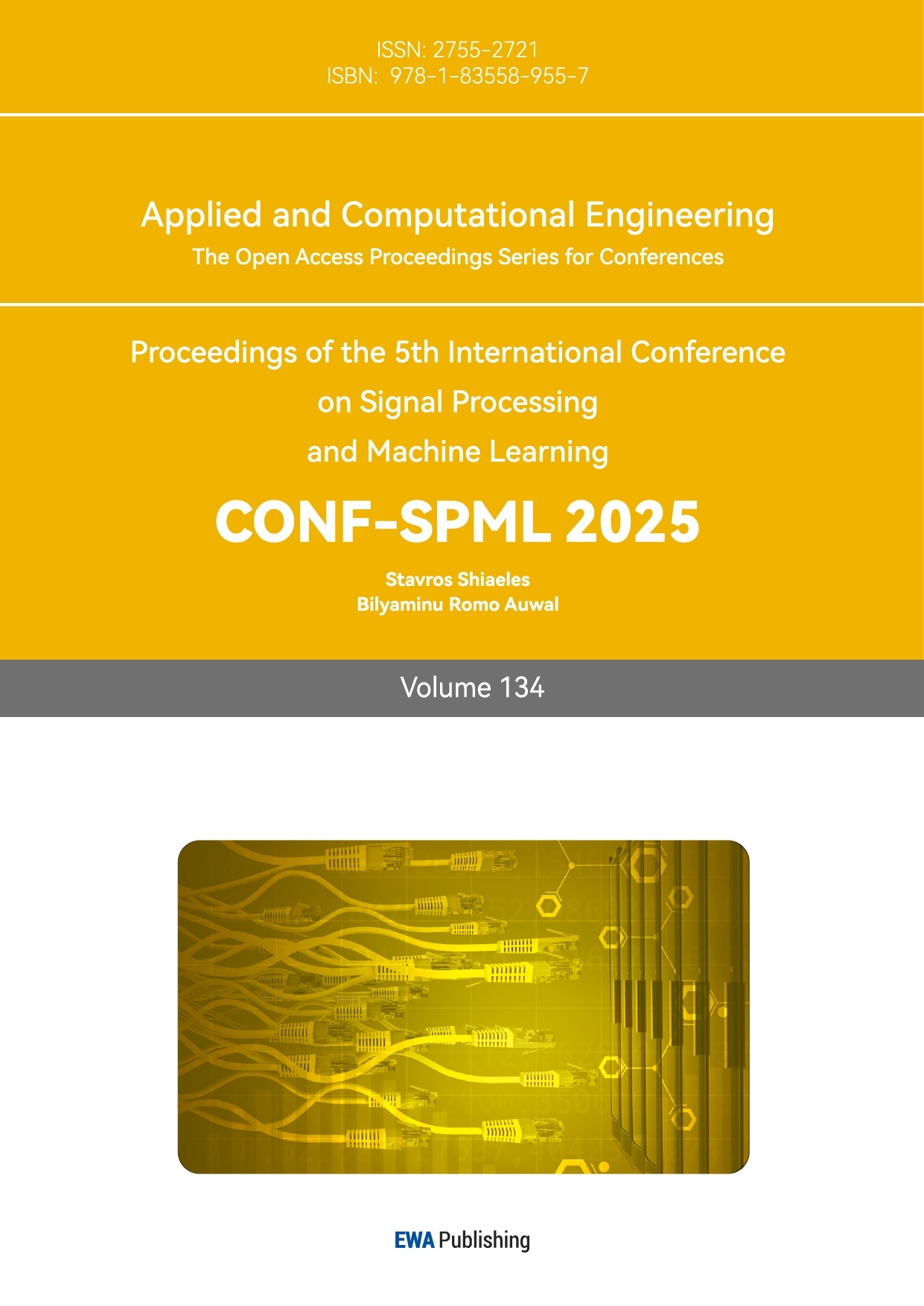1. Introduction
When people look back at the key terms of the 2020s, one topic that cannot be overlooked is the rise of Artificial Intelligence (AI) and its application. Among which, text-to-image and text-to-video are two of the most representative AI generators that are initially applied in the art field.
Since 2014, traditional text-to-image models like Generative Adversarial Networks (GAN) and Variational Autoencoders (VAE) have been used to create images that can be considered as art. In 2018, a GAN-produced piece "Portrait de Edmond de Bellamy" was sold for $432,000, a price high enough to call people’s attention on considering whether AI art can be art [1]. By 2022, advances in Natural Language Processing and Diffusion Models led to text-to-image models upgrades. Representative models such as DALL-E2, Midjourney, and Stable Diffusion lowered the barrier for operation and enhanced image quality, gaining widespread AI art creators and audiences [2].
Furthermore, Language Models and Diffusion Models’ improvements further stimulated the development of text-to-video generators. In February 2024, OpenAI published Sora, which can simulate 60 seconds high resolution videos in realistic or even imaginative scenes based on simple text prompts. This technological breakthrough indicates a giant leap in the quality of AI-Generated Content (AIGC), and shed lights on various art industries, such as film-making, gaming and marketing [3].
As text-to-video technology ushers in a new industrial revolution in art, it becomes imperative to monitor public sentiments regarding the latest advancements in AIGC models, specifically focusing on Sora. This study endeavors to bridge the existing gap by employing digital ethnography to examine the release of Sora. The analysis will encompass thematic and sentiment analysis, drawing insights from an extensive collection of YouTube comments. This paper will adopt a structured approach, incorporating both quantitative and qualitative methodologies, topic modeling, and comparative analysis across different timeframes (before vs. after Sora release) and posting channels (political tendency or professional interest). Through the utilization of mixed-methods and diverse perspectives, this research seeks to capture the prevailing trajectory of public perception towards AI art while identifying potential influential factors.
2. Literature Review
Given the rapid application of AI-generators in the art field, the public held different opinions toward AI-generated art. Based on previous literature (mainly on text-to-image generators), public opinions can be divided into 3 aspects: 1. Creativity and Aesthetic Value, 2. Ethical challenges on future application and 3. Copyrights and legislation. Each aspect will be analyzed through 3 public groups: art critics (theorists), art practitioners (artists), and art consumers (public) accordingly.
2.1. Creativity and Art Value
Art critics held negative attitudes towards AI art’s creativity and aesthetic value. Art critics argued that AI art lacks self-aware creativity and emotion in traditional human art creation processes, thereby rejecting the aesthetic value of AI art [4]. Meanwhile, critics also criticized that AI art lacks narratives, such as the symbolic meaning in expression and historical or individual artist’s background story, making it difficult for aesthetic appreciation [5].
Some art practitioners viewed AI generators as tools to enhance their creativity, but research raised questions whether it can only enhance specific types of creativity. Artists with a positive attitude thought AI-generators can change creative flows [6]. These artists are primarily early adopters who have a stronger sense of relatedness to technology and high autonomy of controlling over technologies [7]. Research also indicated AI-assisted artists can effectively explore more creative conceptual content, although the overall novelty in the artwork's content and visual elements may decrease [8].
Recent studies [9-12] also showed that art consumers generally had a negative bias of aesthetic value towards AI art. But judgment towards AI art’s commercial value can be enhanced by their personal positive experiences with AI technologies, which can be shaped by media messages. Surveys [13] indicated that art consumers tend to rate AI-labeled artwork lower in terms of liking and beauty compared to human-labeled artwork, as they believe that story-telling and effort behind AI art are limited. However, the same surveys also found that individuals who have had positive personal experience with AI gives AI art higher rates on profundity and worth. Other researchers [14] further explained that exposure to technology-related content (such as technology news and science fiction) and social media framing (such as tweets advocating AI generators as tools to produce real art) can positively influence the public's attitude towards AI art. Besides, surveys conducted on California residents have shown that political preference can influence perceptions of AI, with right-wings individuals more likely to support AI if the tone of AI news reports aligns with their values [15] .
2.2. Ethical Challenges on Future Applications
As AI generators gained scalable users and audiences in various art industries, ethical concerns emerged. Theorists, artists and art consumers all feared that AI could unfairly replace human artists. Economists studying the labor force identified eight stages of the creative process, finding AI to be more efficient at some stages [16]. Artists argued that this technological upgrade reduces the need for human creators, affecting jobs and wages for composers, designers, and writers [17,18] . Art consumers similarly saw AI as a threat that “steals” both jobs and artistic styles from human artists, no matter if they were for or against AI art [14].
Additionally, art consumers worried about AI-generated contents’ potential to produce unethical material, which could spread misinformation and undermine trust in media. While the public has accepted analyzing information through text-based AI generators, they remained cautious for life-like AI technology such as audio with voice replication and hyper-realistic AI images. Many advocated for strict regulation of fake media content [15]. These views reflect broader concerns over the ethics, truthfulness, authenticity, and fairness of AI in the arts.
2.3. Copyright & Ownership
Art critics contemplated AI art’s ownership, whether it belongs to AI itself or humans. And concluded that it is mainly correlated to the extent of human involvement in generative processes [17]. Other lawsuit theorists questioned that current legislation lacks policies to protect AI-art copyright protection [19], and called for US court and US copyright office’s action [20].
On the other hand, art practitioners held a negative attitude, concerned about human artists' copyright infringement. Artists community worried about whether AIGC model datasets use artists’ work without consent, plagiarize their style and cause artist’s reputation damage and economic loss [18]. Some researchers even gave human artists legal advice such as using misappropriation laws to protect their rights [17].
2.4. Current Limitation and Future Research Directions
Previous research has explored public reactions to AI art in depth, but these opinions have predominantly centered on text-to-image generators. Research on public opinion regarding text-to-video generators needs to conduct, and further test whether public opinions on up-to-date technology carry the same themes and sentiments compared to that of text-to-image generators.
Besides, research on text-to-video generators is also stabbed by several limitations in method design: First, research methods were limited and sample sizes were insufficient. Mogavi [21] used only qualitative research, choosing content analysis to analyze Reddit comments towards Sora. Parikh [22] further employed a mixed method, incorporating qualitative tools to select high-frequency topics, but sample size only covered five subreddits under 2,000 comments. Second, timeframes were short and asymmetrical. Mogavi [21] covered only 7 days after Sora release. Parikh [22] spanned two months, but 15 days before and 45 days after Sora release. Asymmetric time periods hinder the way to accurately compare trend frequency.
Hence, a research model that combines qualitative and quantitative research, utilizes a large sample size, and incorporates balanced timeframes to analyze public opinions on AI art created by the updated text-to-video generator Sora is needed to conduct in the future. This study will focus on developing such a model.
3. Methodology
3.1. Research Aims & Design
Drew lessons from previous literature review, this study aims to address three research questions (RQs):
• RQ1: What are the public opinions on AI art created by text-to-video generators?
• RQ2: Do public opinions and emotions change across time?
• RQ3: Are public opinions and emotions different across posting channels?
For RQ1, OpenAI Sora is chosen as the representative text-to-video generator due to its technology breakthrough in the industry. Comments from YouTube videos produced by artists, technicians and art consumers are gathered. To collect public opinion, both text classification (quantitative) and digital ethnography (qualitative) approaches are employed. For RQ2, the time range is defined as 2023.12.15 to 2024.4.15, ± two months before and after Sora's release on 2024.2.15. A two-month period allows for convenient data collection and enables a comprehensive capture of the changes in public opinion triggered by the release of Sora to a large extent. To address RQ3, a two-dimensional analysis was conducted. First, comments from the U.S. right-wing and left-wing media sources were selected. Second, comments from two individually-owned channels, representing viewpoints from the art and technology sectors, were analyzed. These two groups were selected to capture a broad spectrum of political and professional opinions relevant to the discussion.
The research uses a mixed method, a kind of method to combine the quantitative (text classification and frequency statistics) and qualitative (examining the content and subject matter of comments) together to solve these questions. Two useful tools, MDCOR (Machine driven classification of open-ended responses) and SENA (Sentiment and Emotion Network Analysis), are used to analyze Youtube comments. Through which, machine learning can show data in metrics efficiently, and content analysis of 20 most representative comments for each topic can retain original emotion and reasoning behind participants' comments [23].
3.2. Sampling & Data Collection
The study is based on original comments from eight YouTube videos’ comment sections (N = 11,929), ranging from 2023.12.15 to 2024.2.15 [24-31]. Sample for (N = 1,967) for public opinion analysis before and after Sora release (RQ1,2) and four videos (N = 9, 962) for comparison among posting channels (RQ3). These comments were extracted by publicly available API provided by Youtube, and imported into R Studio for further analysis.
The criteria for the video’s selection are: 1. Video comments exceed thousands (N >1,000) in order to ensure sufficient samples and reduce unnecessary bias. 2. Video publish dates are unified. For RQ1 and 2, four videos [24-27] all published before 2024.12.15 so as to cover ± 2 months of Sora's release. For RQ3, four videos [28-31] all released on the same date 2024.2.16 to control variables. 3. Diverse video source to include different public groups and media channels. For RQ1 and 2, videos [24-27] are produced by one artist, one art critic, and three art consumers, and video contents cover positive/neutral/negative attitudes towards AI art. MDCOR and SENA were used to assess the thematic and emotional differences between these groups. For RQ3, videos [28-31] are released by one left-wing channel NBC, one right-wing channel WSJ, one from technology influencers and one from art-focused influencers. By this means, different public groups, political tendency and media framing are set as variables that can alter public’s perception of AI art.
The criteria for comments data-cleaning are: 1. Exclude non-English comments 2. Remove stop words (such as “the”, “have”, ‘think’), numeric characters, and punctuation. 3. Delete flooding comments (repetitive and irrelevant comments) 4. Apply lemmatization. These criteria are applied to exclude words that contribute less to the meaning of topics, ensuring the accuracy of the analysis. To be mentioned, emojis which cannot be identified by MDCOR are converted into text using code to ensure original sentiment analysis.
3.3. Data Analysis Techniques
To employ a mixed method, qualitative tools are used for topic and sentiment identification. After data are trimmed according to criteria mentioned above, data is loaded to MDCOR for data mining. MDCOR then optimizes the algorithm and generates metric assessment for topic extraction. The greater the agreement between the metrics, the more trust will be in selecting the optimal number of code, which is also the number of topics [23]. As indicated in Plot 1, public opinions on AI art have three topics before Sora release and four topics after Sora release. Followed by the same procedure, four media channel videos all have two topics respectively, which are unified for contrast.
SENA, another qualitative tool also known as opinion mining, is a method of determining an author's or user's emotions about a subject by detecting attitudes in a text. It uses natural language processing techniques to extract valuable information and semantics from text to identify and assess the author's emotional tendencies. Through this process, it is possible to determine whether the emotions expressed in the text content are positive, negative, or neutral [32]. Emotion detection, also known as emotion recognition, is a process used to identify and judge different emotions or emotions expressed by a person, such as happiness, sadness, or anger [33]. SENA is used to generate the distribution of emotions in the form of histogram and word cloud. To increase centralization, SENA analysis only involves each topic’s top 20 representative Youtube comments generated by MDCOR.
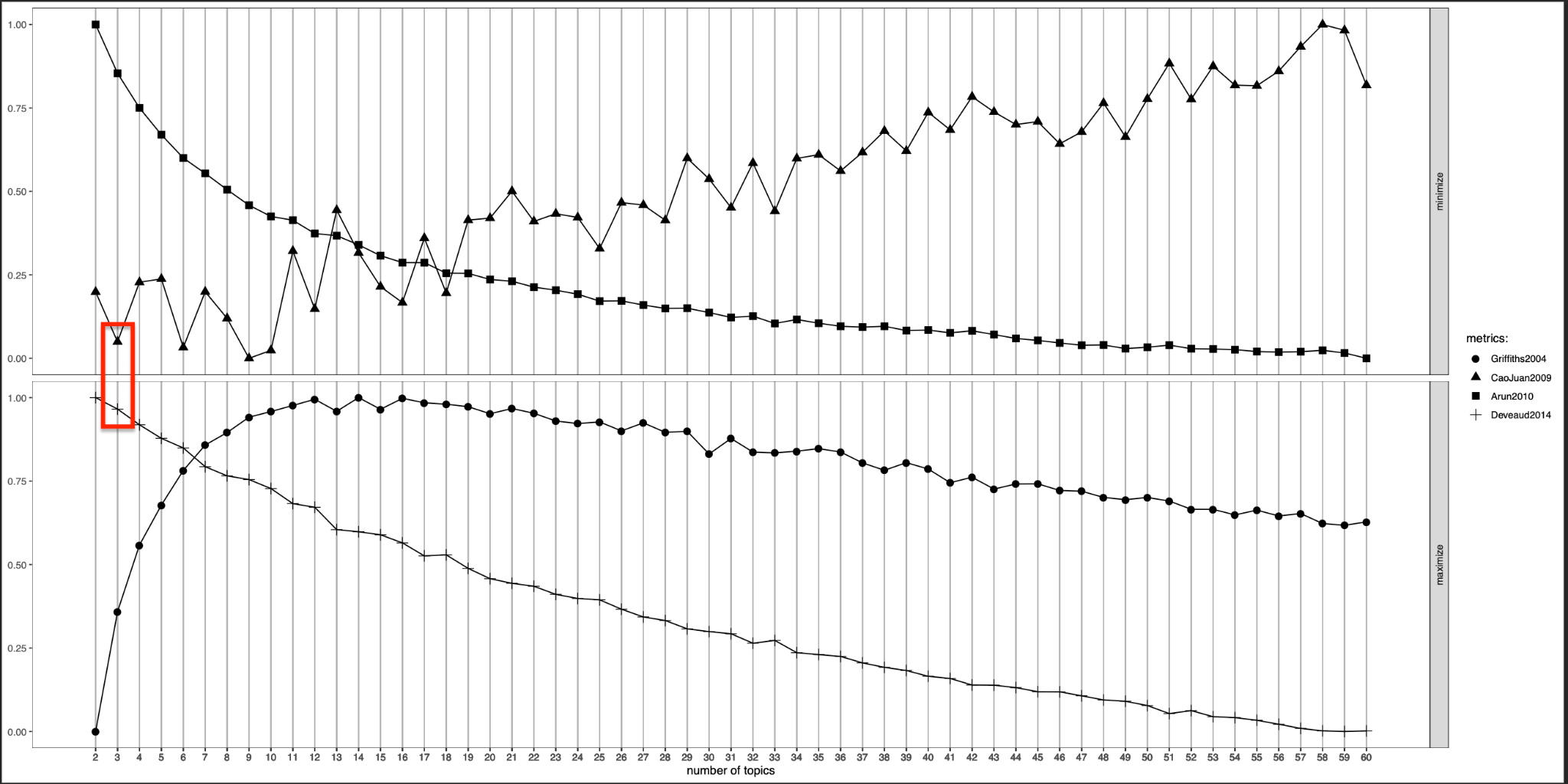
Figure 1: Metric assessment for topic extraction before the release of Sora

Figure 2: Metric assessment for topic extraction after the release of Sora
In order to gain a deeper understanding of nuanced topics and emotions without losing context, qualitative analysis will also be supplementary. Quote analysis will be conducted by putting high frequent keywords of each topic back to its original comment and analyzing the tone, ideas and patterns of context. Quote selection will be based on these contents generated by MDCOR code: 1. Top 30 most salient terms with high frequency and 2. Top 20 representative comments with high “relative text contribution,” meaning these quotes best aligned with and exemplified the theme of the respective topic.
3.4. Replicability and effectiveness
To ensure repeatability of the research, detailed records of all methods, tools and procedures used for data collection and analysis have been kept. The use of standard APIs, along with widely accepted content and sentiment analysis frameworks, ensures that the results are reliable and can be replicated by other researchers exploring similar questions.
By combining quantitative sentiment metrics with qualitative subject identification, this approach provides a comprehensive picture of the changing public perception of AI-generated art in the context of Sora's release. This comparative approach also highlights the impact of media framing, providing valuable insights for researchers, media analysts, and AI artists.
4. Results & Analysis
4.1. RQ 1&2: Public opinions about AI art before and after Sora’s release
To examine the themes of the comments before and after Sora’s release, we used MDCOR to filter out the words and the quotes that are the most representative, and then we summarize the topic based on those words. As for comments before the release of Sora, MDCOR determines three different topics, as shown in Table 1.
Table 1: “Before the release of Sora” topics determined by MDCOR
Topic | Topic Name | Words |
Topic 1 | Realism and completeness of AI art | look, time, something, draw, real, even, feel, still, picture |
Topic 2 | AI’s contribution on art creative flow | good, work, image, tool, video, create, also, style, generate |
Topic 3 | Mixed emotion towards AI art | human, heart, tear, want, steal, hand, never, train, smile, doesn’t |
Summary | People adopt AI in art conceptual process and final output, but attitudes are mixed. | |
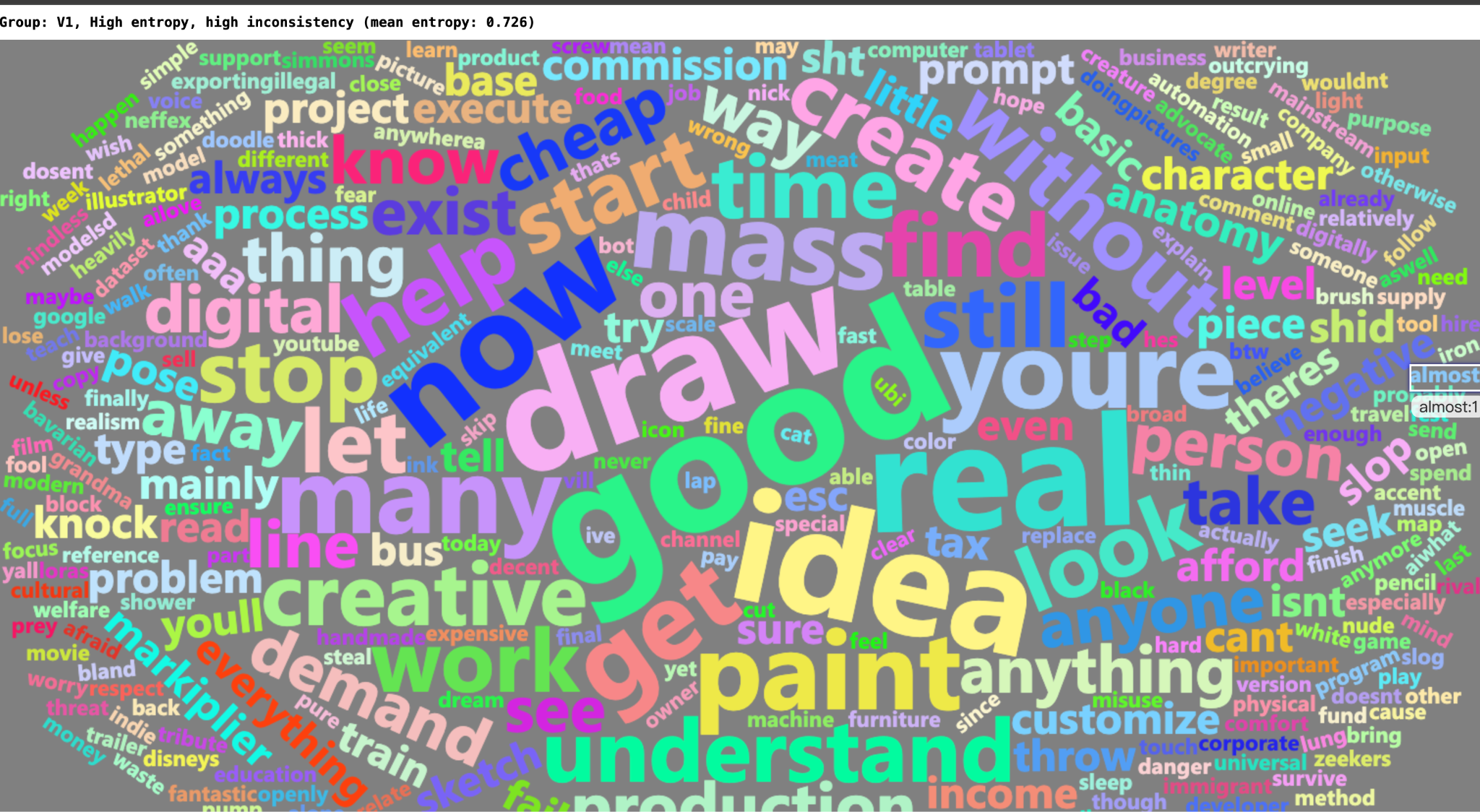
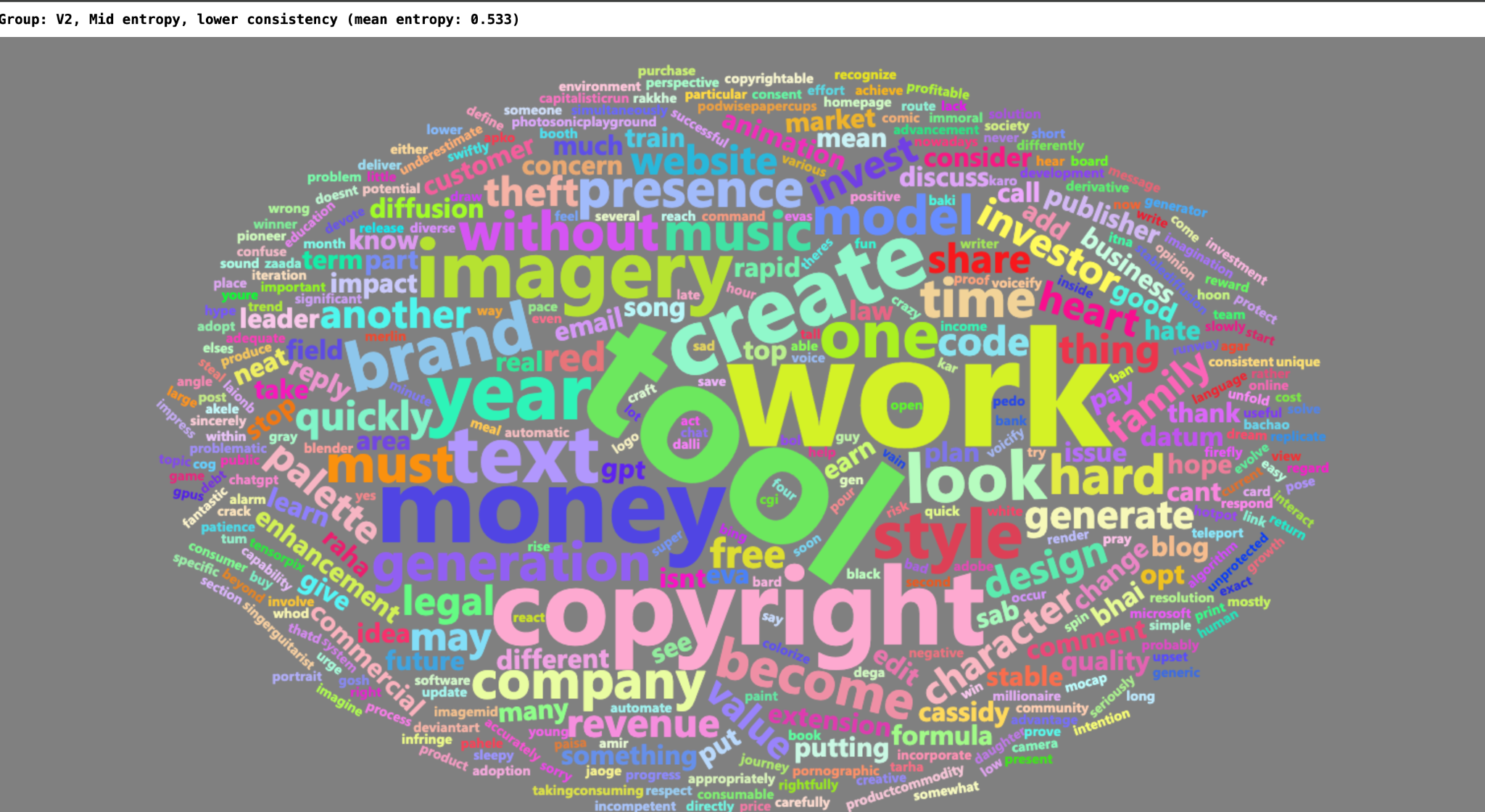
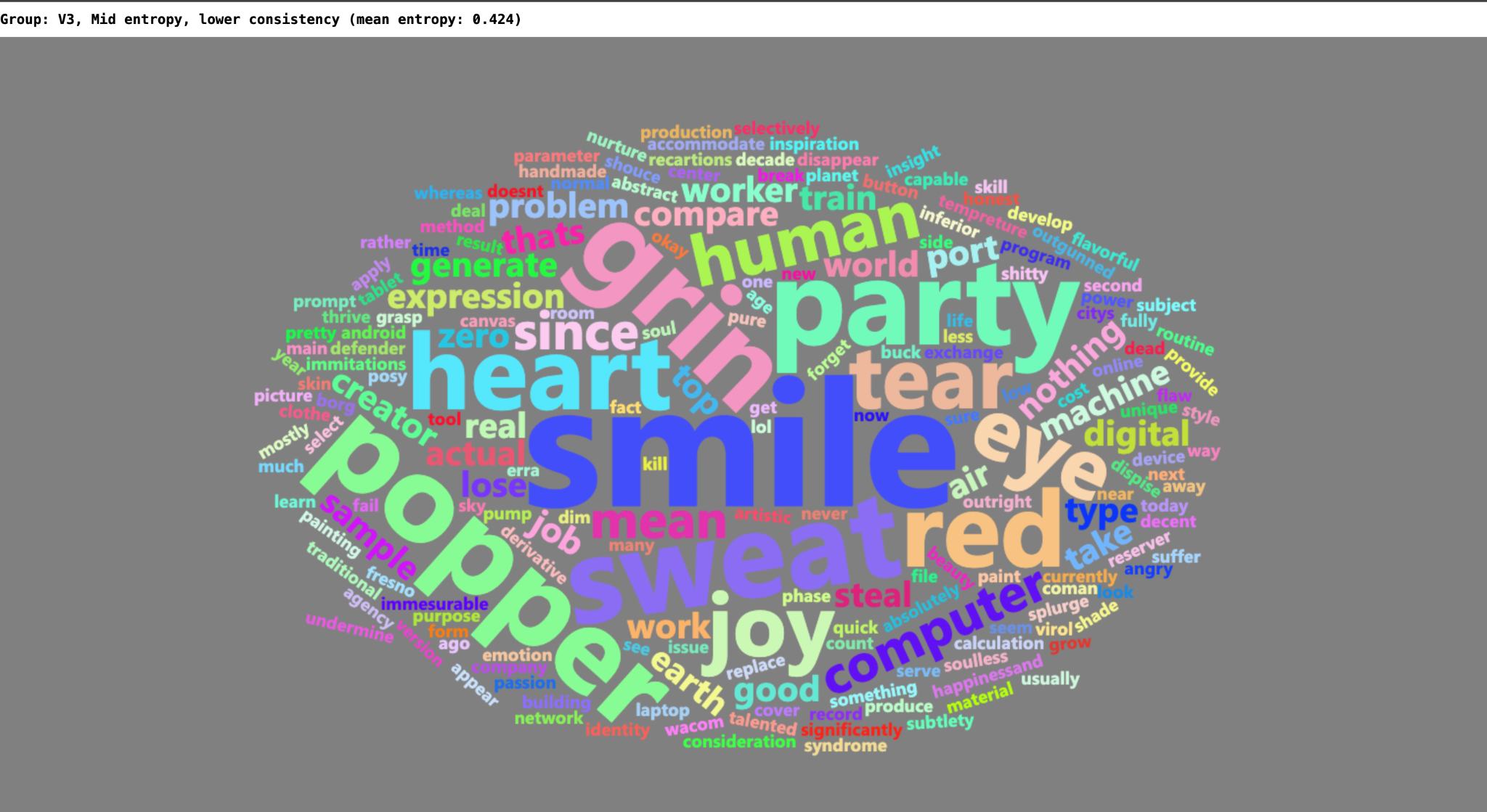
Figure 3: “Before the release of Sora” word clouds visualized by SENA
Topic 1 is “Realism and completeness of AI art”. Publics are already impressed by the completion and realism of AI-generated content, keywords such as “good”, “real” and comment of @BrandonFerrentino “What's the difference between that and a human looking at a reference to draw? Art doesn't exist in a vacuum.” all represent the public's impression. Topic 2, labeled as “AI’s contribution to creative flow”. Keywords like “tool”, “work”, “create” and comment “I use chat gpt to come up with character ideas. It's good for me because I'm out of creativity, face with tears of joy” said by @GotZeroTime indicate AI’s participation in the conceptual process of art. Topic 3 can be characterized as “Mixed emotion towards AI art”, keywords such as “smile”, “heart”, “party” represent emojis in original comment, such as smiling face, red heart and party popper. Other keywords such as “steal”, “never”, “doesn’t” are on the critical and negative side.
For comments after the release of Sora, MDCOR classified into four different topics, as shown in Table 2
Table 2: “After the release of Sora” topics determined by MDCOR
Topic | Topic Name | Words |
Topic 1 | High-quality AI art and threat on artist | good, time, even, draw, come, life, someone, still, mean, find, steal |
Topic 2 | AI training process and potential economic loss on stakeholders | work, create, thing, generate, also, look, really, train, model, copy |
Topic 3 | AI's application on entertainment industries | human, real, never, world, learn, replace, feel, future, always, industry, music |
Topic 4 | Positive attitude to learn more about AI as tools | tool, tear, heart, give, hand, smile, sweat, grin, sora, hold |
Summary | Advanced AI art’s impact on human artists, entertainment industries and legislation. | |
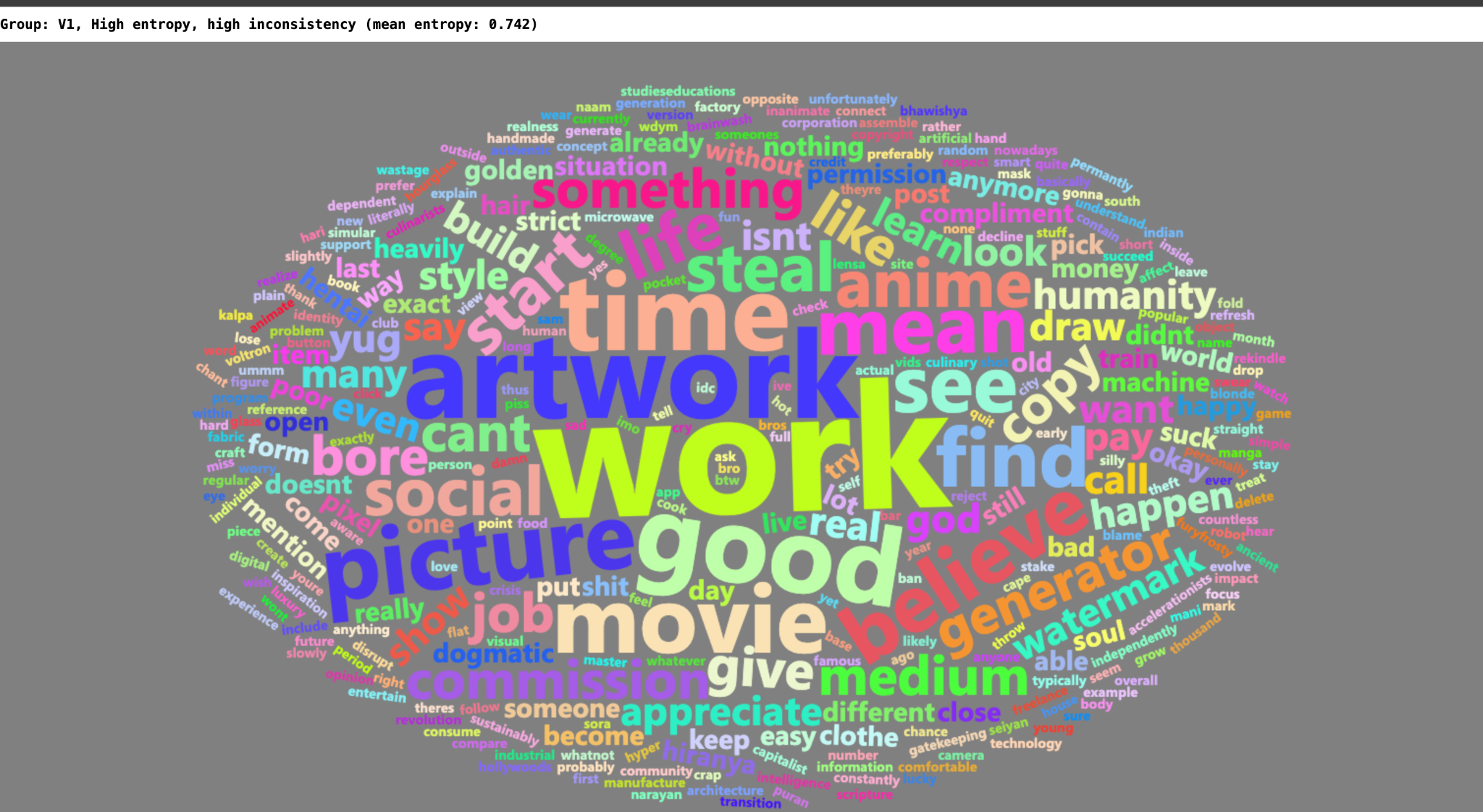
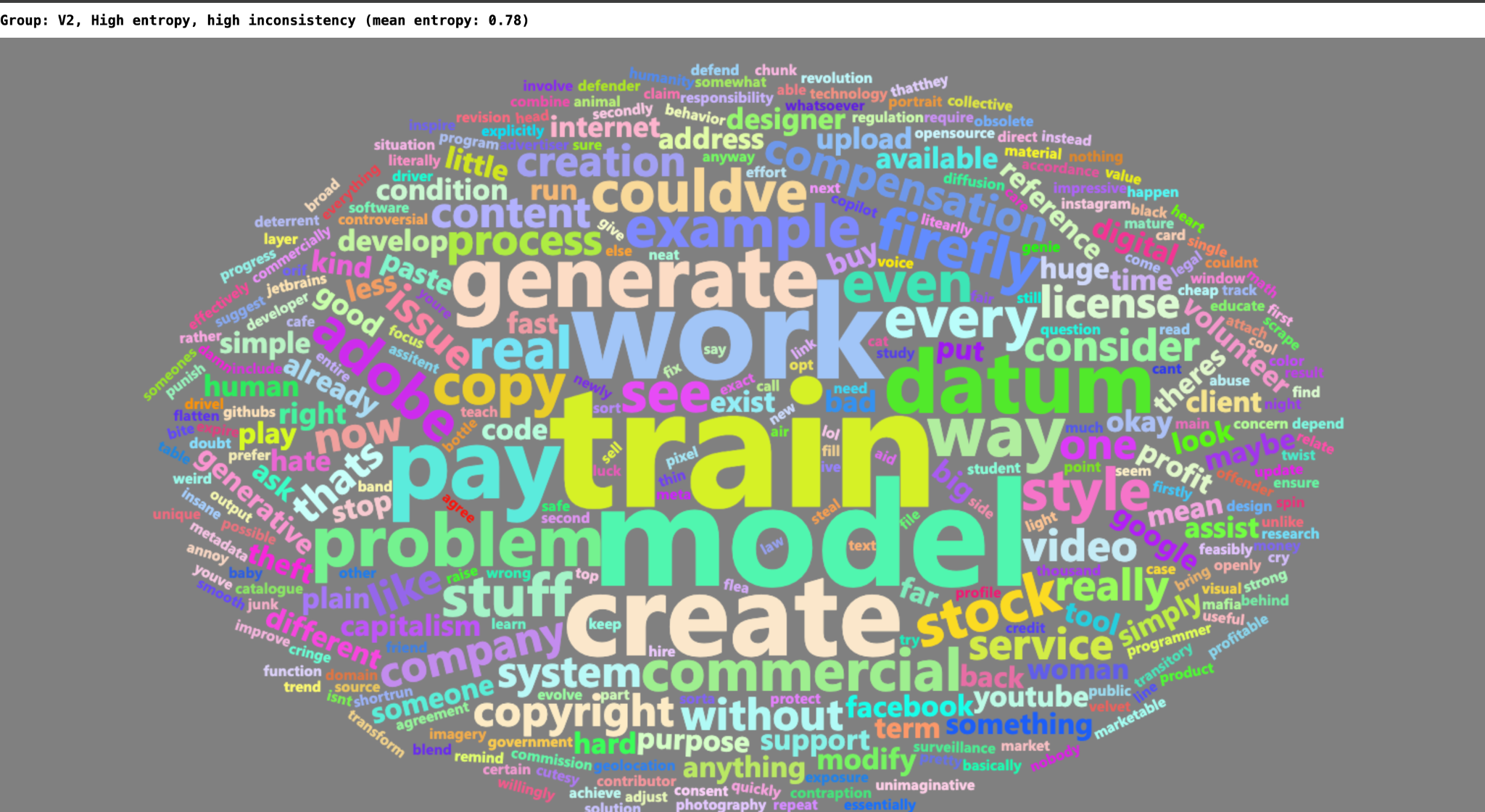
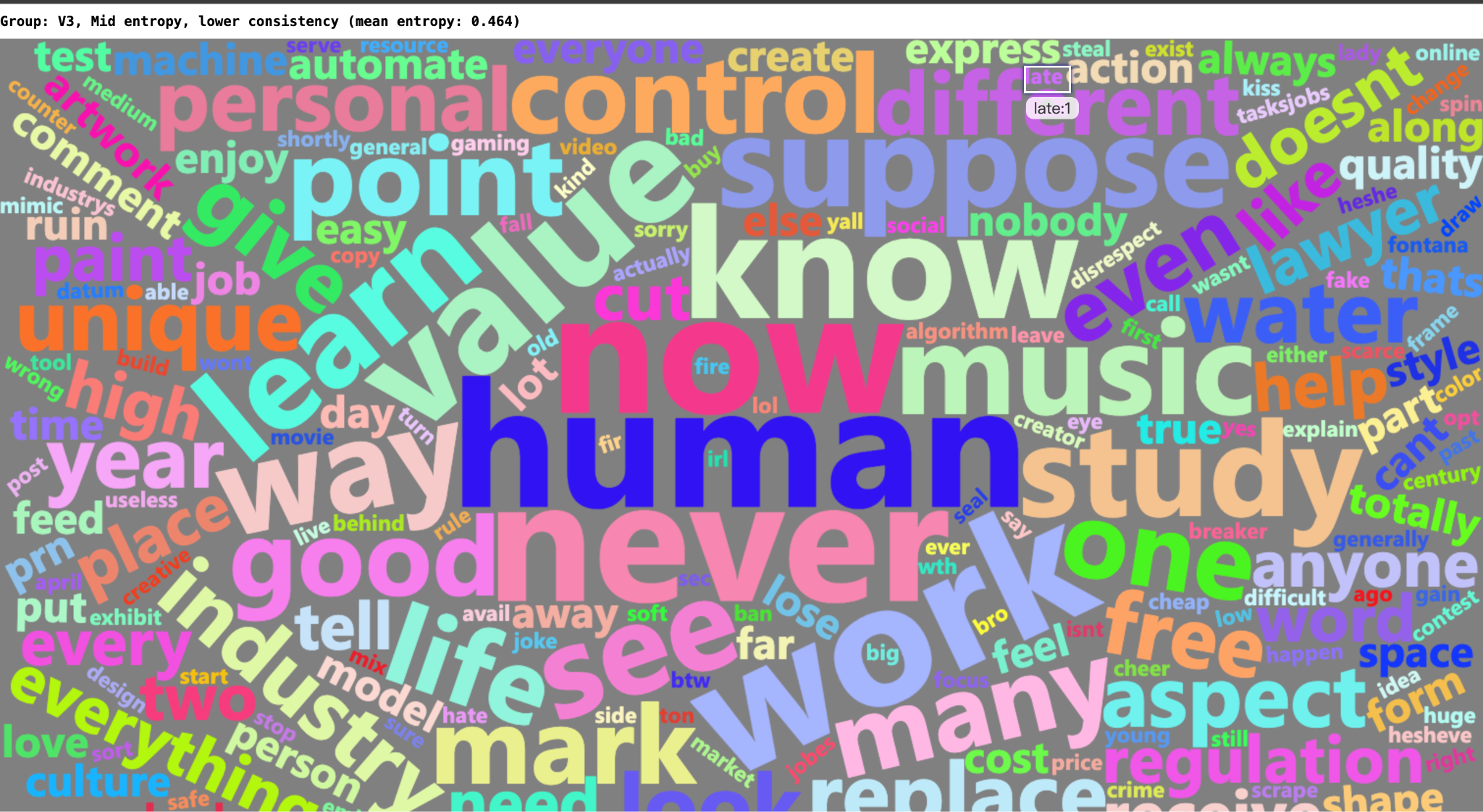
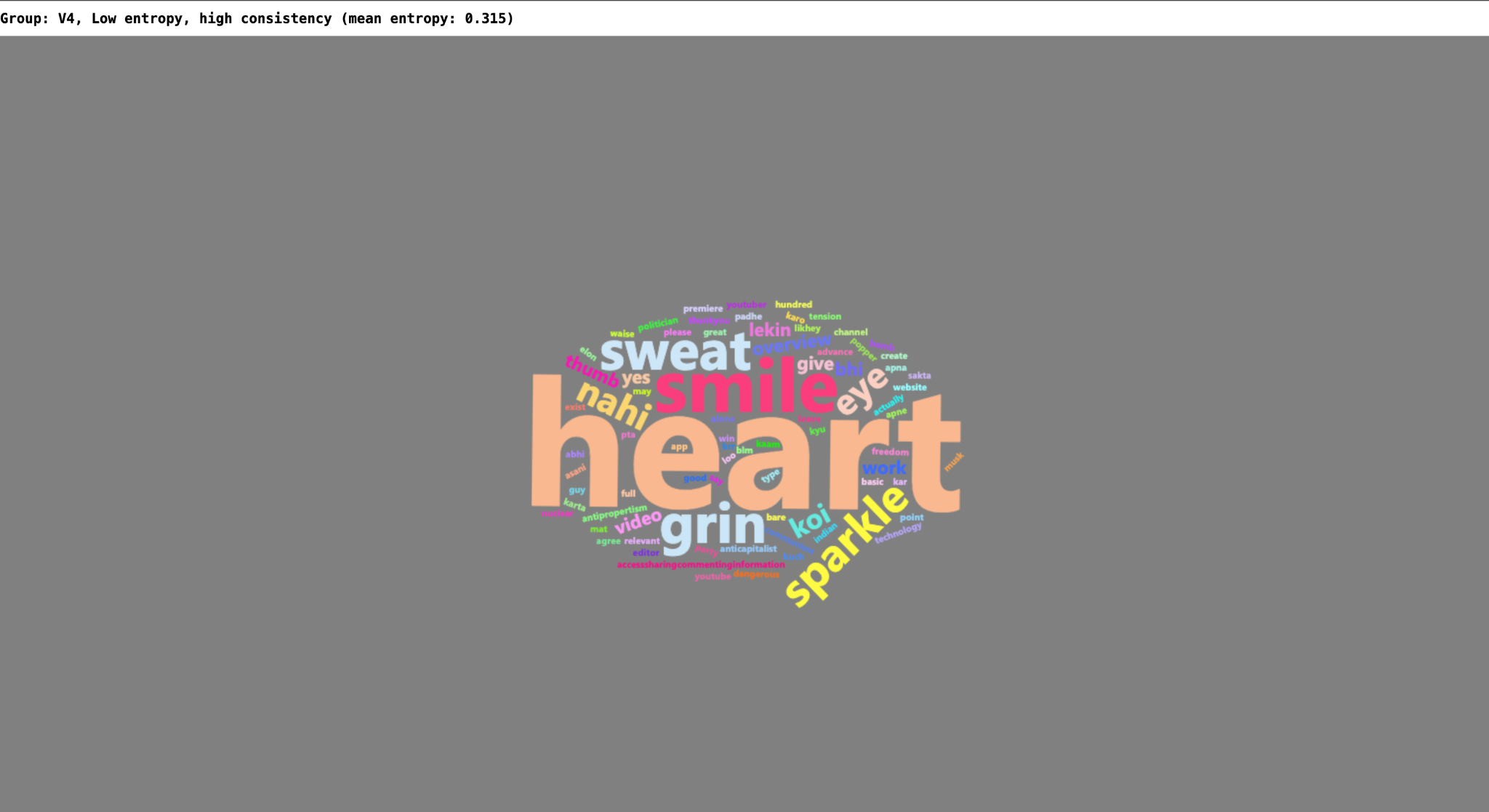
Figure 4: “After the release of Sora” word clouds visualized by SENA
Topic 1 is “High-quality AI art and threat on artists”. This topic echoes with “before the release of Sora” topic 1 “Realism and completeness of AI art”. After the release of Sora, keywords such as “good”, “draw” and “life” indicate a heightened appreciation among people for the quality of AI art outputs. By comparing original comments before and after the Sora release, people continue to compare AI art with human artwork, but emphasis has shifted. Comments now reflect a sentiment that “it feels real artists are gonna fall by the wayside in favor of AI which can generate in seconds than a human puting their skill into a beautiful piece” by @noonesishome. Human artwork is no longer seen as the standard for measuring AI art quality and completion; rather, it is perceived as potentially being replaced by AI art. The keyword “steal” generated by MDCOR also corroborates this notion. This shift confirms that, post-Sora release, many believe there has been a technological leap in AI art quality.
Topic 2 addresses the “AI training process and potential economic loss for stakeholders,” paralleling discussions on “copyright and ownership” found in the previous literature review section. The keywords such as “generate”, “train”, “model” and “copy” along with @frasermacdonald6614 comments “Generative visual AI models do not require the use of copyrighted material—it's just faster and cheaper to use (abuse) it to train models in the short run.” reflect concerns about the underlying principles of AI generator models and datasets, particularly regarding whether they are based on the works of human artists without consent. In this scenario, if AI art becomes commercialized, the question of whether human artists can receive compensation will arise.
Topic 3 explores “AI's application in the entertainment industries”. Indicated by keywords such as “future”, “industry” and “music”, public concern AI art's impact on various art sectors. A comment by @UncannyValley333 illustrates this through the statement: "The music industry went through this 25 years ago. Recorded music used to have a lot of value. Then MP3's came along and the industry had to totally revise its business model. Tons of careers were destroyed. So many artists lost their contracts. So many labels went under. Now Apple and Spotify own the entirety of music, and artists have to give their work away for free. Literally no choice. They can opt out and not put their music on those platforms but then nobody will listen." This comment comprehensively outlines the historical context of the music industry while suggesting the potential subsequent impacts of AI art.
Topic 4 describes “positive attitude to learn more about AI as tools”. Similar to “before the release of Sora” topic 3, this topic consists of emojis, but positive emojis predominant. These emojis are linked to the keyword “tools”, as reflected in comments of @tobeknown7018 “Detailed video on AI tools folded hands folded hands folded hands folded hands” further illustrate people’s favorable attitude towards AI-related subjects.
For sentiment analysis, Figure 5 and 6 represent public sentiment before and after the release of Sora.
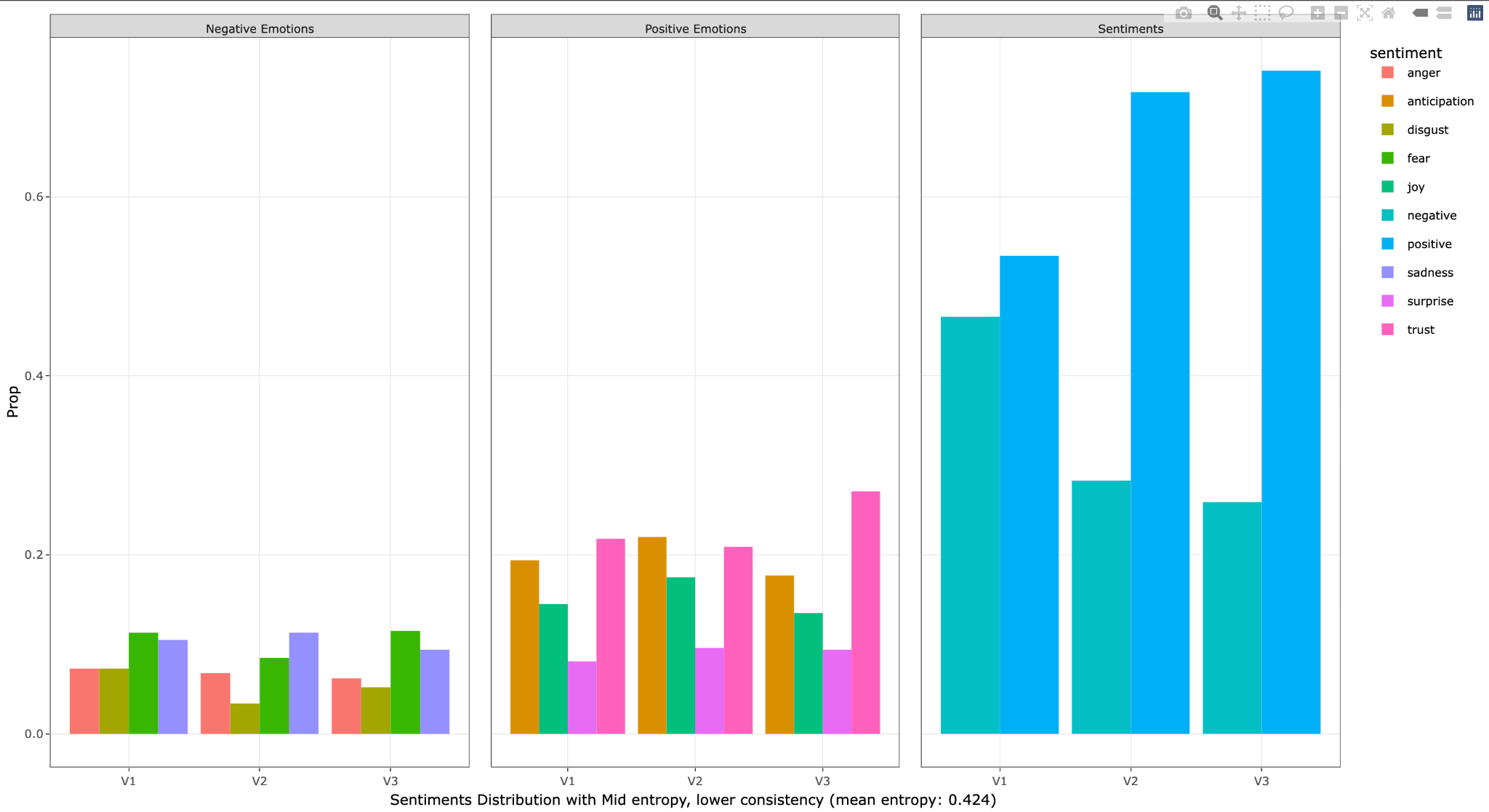
Figure 5: SENA analysis of sentiments of comments before the release of Sora
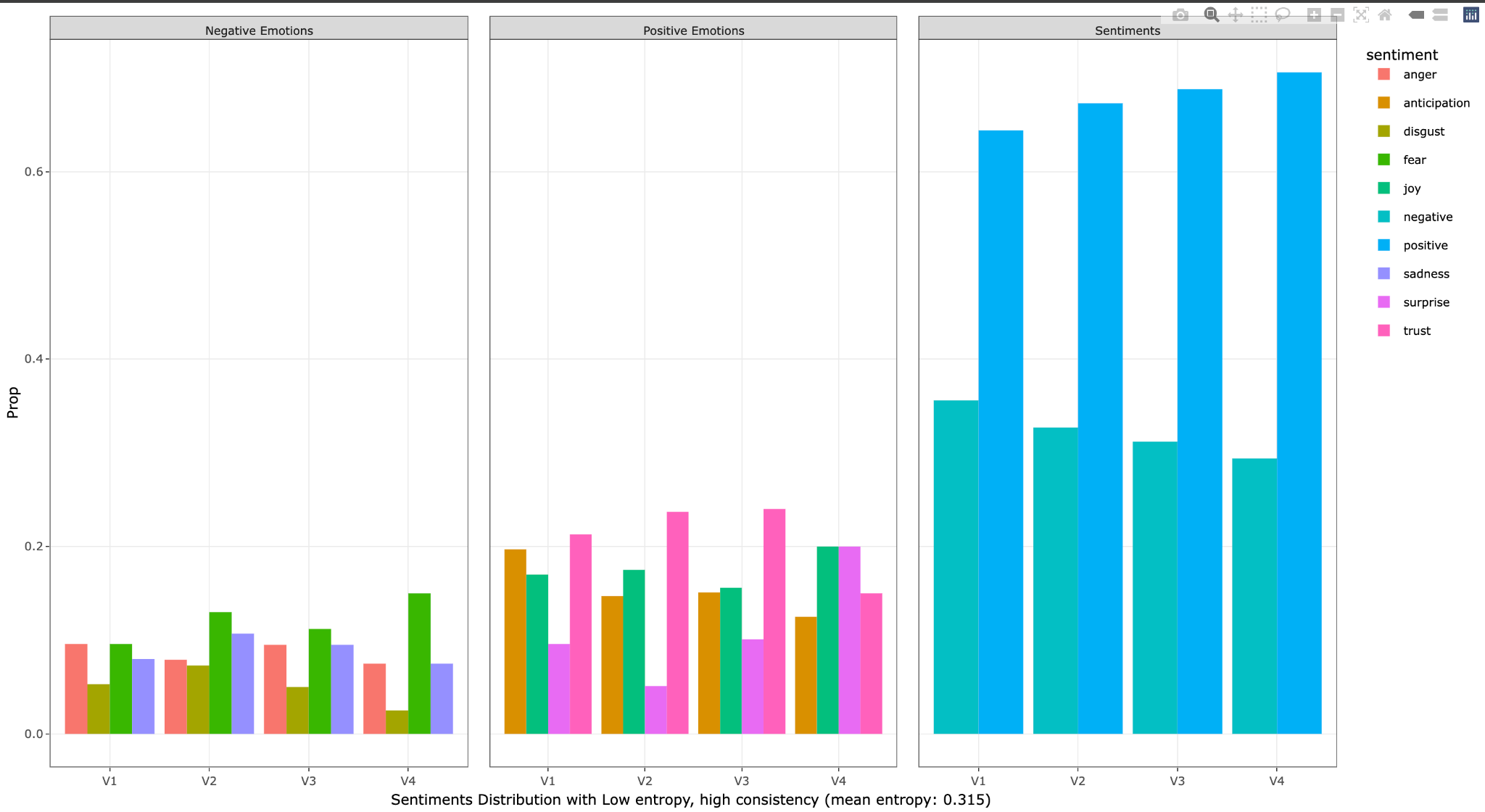
Figure 6: SENA analysis of sentiments of comments after the release of Sora
A common feature of the two graphs is that positive emotions outweigh negative emotions. By comparing the data before and after the release of Sora, Figure 6 demonstrates a significant increase in positive sentiments (mostly in trust) relative to Figure 5, indicating that the release of Sora has influenced public perception and significantly boosted confidence in AI art. Meanwhile, there is a notable rise in fear following the release of Sora, which may come from human artists about the potential for being replaced by AI art and the risk of losing their careers.
4.2. RQ 3: Public opinions and emotions difference across posting channels
Comparison 1: NBC vs. WSJ
The first set of posting channels to be analyzed focuses on contrasting political stances. NBC and The Wall Street Journal (WSJ) are selected to represent the left-leaning and right-leaning perspectives in the United States, as they embody two of the most distinct political ideologies. To examine the themes of the comments under NBC and WSJ channels, we used MDCOR to filter out the words and the quotes that are the most representative, and then we summarize the topic based on those words. For NBC, MDCOR determines two different topics, as shown in Table 3.
Table 3: Topics determined by MDCOR for NBC
Topic | Topic Name | Words |
Topic 1 | AI's creative potential vs. ethical concerns and inauthenticity | good, create, time, world, come, life, technology, civilization, replace, work, tool, fake, stop |
Topic 2 | AI's future: personalized entertainment and societal disruption | generate, movie, real, look, future, joy, tears, imagine, soon, tear, skull |
Summary | AI's disruptive impact on creativity, authenticity, and the future of media. | |
Topic 1 explores AI's creative potential versus ethical concerns and inauthenticity, focusing on words that reflect both the positive possibilities (such as words "good," "create") and the negative ethical concerns (such as words "fake," "replace," "stop"). It embodies the dual nature of AI in the creative field. On one hand, AI is seen as a tool with immense potential for creativity, innovation, and efficiency. On the other hand, ethical concerns arise, particularly around authenticity and the replacement of human effort. According to the most represented quotes that are selected based on the highest “relative text contribution”, @ModeratelyAmused believed AI would “allow the creative to be more creative”, indicating the belief towards its creative nature. However, @marcuscarana9240 held a contrasting view by commenting that “It will create more problems than it solves”, expressing the concerns towards its authenticity.
Topic 2 delves into AI's future in personalized entertainment and societal disruption, capturing the way AI may generate personalized content but also incite fear about its societal impact (such as words "real," "future," "skull"). According to @jannekallio5047, “Soon anyone can create any movie or series by themself,” but it may potentially “disrupt the foundations of trust” given the comments by @darrylloke3296. This topic addresses the implications of AI’s role in creating personalized experiences, particularly in entertainment, and the fear of broader societal disruptions caused by these advancements.
By clustering the related words, the analysis reveals public sentiments and areas of tension, showing a contrast between AI's perceived potential and the anxieties it raises. The summary encapsulates the disruption AI poses to core values in media and creativity, emphasizing both excitement and apprehension toward its growing influence.
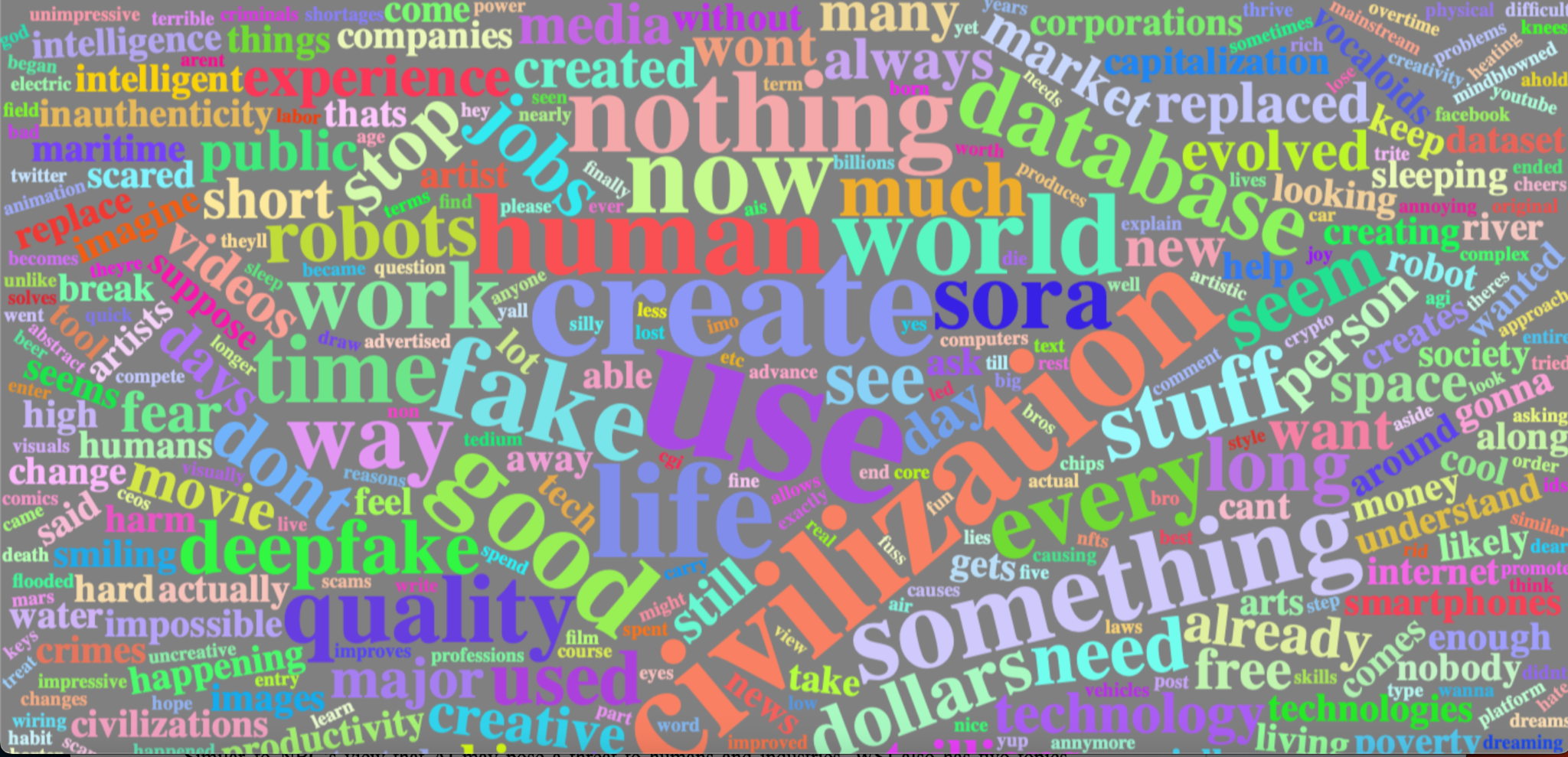
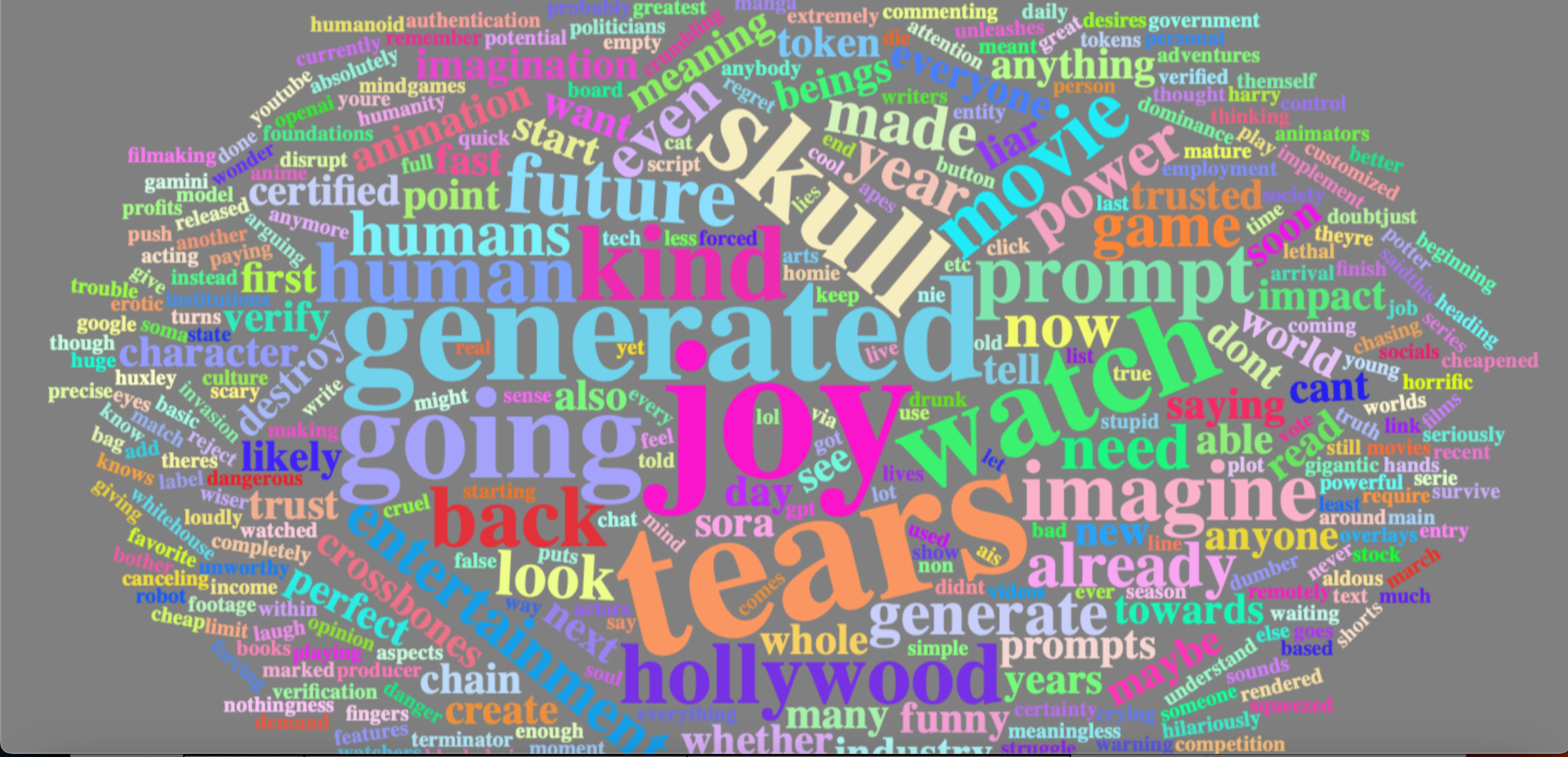
Figure 7: Word Clouds Visualized by SORA for NBC Channel
As shown in Figure 7, NBC’s word clouds highlight AI’s impact on creativity and industries, with terms like "create," "fake," and "technology" reflecting concerns about authenticity and innovation. Words like "generated" and "joy" emphasize AI’s potential in entertainment, showing a more proactive view, though ethical concerns remain.
Table 4: Topics determined by MDCOR for WSJ
Topic | Topic Name | Words |
Topic 1 | AI's impact on content, industries, and the need for regulation | world, technology, imagine, content, real, industries, film, political, come, fake, corporations, company |
Topic 2 | AI vs. human creativity and authentic connections | Hollywood, music, movie, human, create, future, reality, generate, artist, doom, crazy |
Summary | AI's impact on creativity and the need for regulation. | |
Similar to NBC’s view that AI may pose a threat to humans and industries, WSJ also has two topics posing similar but different perspectives, which can be shown in table 4. Topic 1 centers on AI’s impact on content, industries, and the need for regulation. The word uses such as “content”, “industries”, “film” and “political” indicates that AI is applicable on a wide range of various industries and has significant impacts. Nevertheless, “fake” underlines the concerns about its applications and urges the need for regulation as shown by the words such as “corporations” and “company”, indicating the approaches of regulation. As mentioned by @pavel_zenin, “services like these are essential for automated content regulation.” The need for regulation is emphasized as a way to balance these opposing forces, ensuring that AI's integration into industries is ethical and managed responsibly.
Topic 2 focuses on AI versus human creativity and authentic connections, comparing AI's ability to generate creative output with human-led processes and its effect on authentic human connection and artistry. In certain fields such as music and films, the contrasting words "human", “create” and "generate" highlight the core issue: whether AI can genuinely replicate the emotional and creative depth of human creators in the future. Words like "doom" and "crazy" suggest a fear of the unknown, implying that unchecked AI advancement could potentially harm traditional creative industries and diminish human connection in artistic expression. As suggested by @FcoGabler, such AI tools may become the threats to “creativity and imagination of any artist,” and post a critical question of whether “genuine face-to-face human connections will once again take center stage” according to @1973navino.
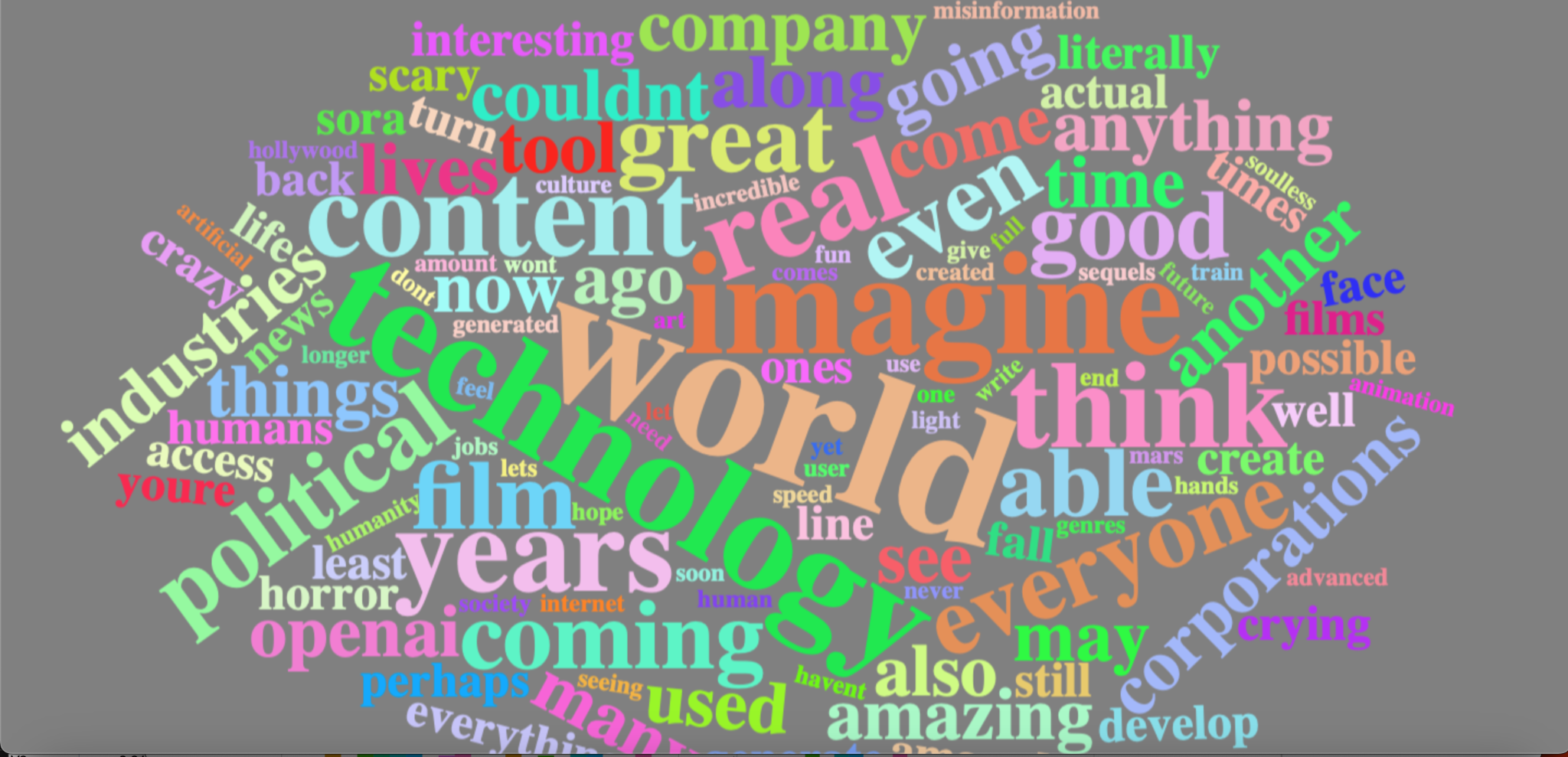
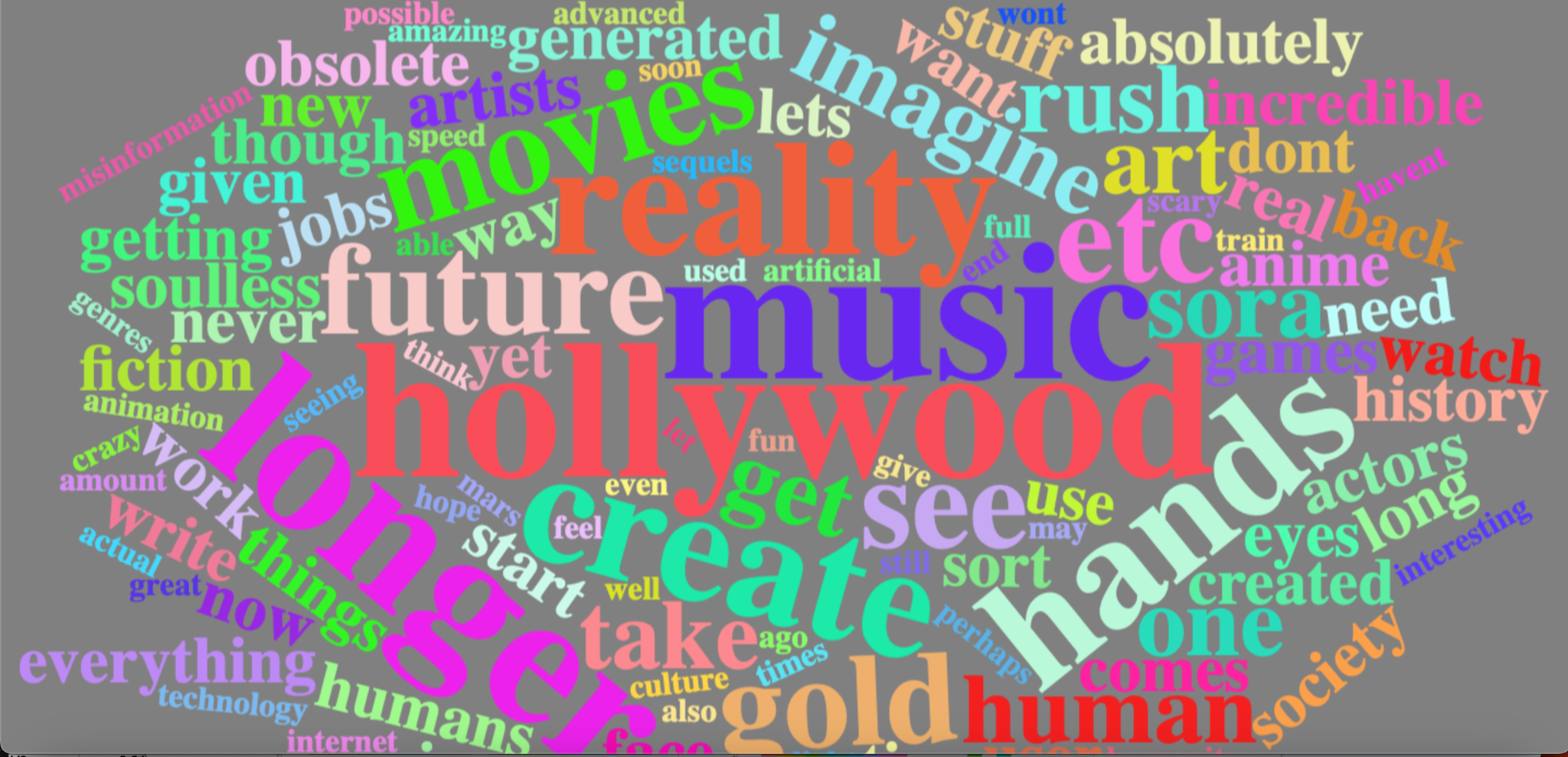
Figure 8: Word Clouds Visualized by SORA for WSJ Channel
As shown in Figure 8, the word clouds for WSJ’s channel reveal a focus on AI's impact on content, industries, and the need for regulation, with words like “technology,” “imagine,” and “fake” highlighting both its potential and concerns about authenticity. Another theme centers on AI versus human creativity, with terms like “human” and “generate” reflecting the debate over AI's ability to replicate genuine artistic depth. Overall, WSJ emphasizes the importance of regulating AI to safeguard human creativity and ethical standards.
While both channels expressed their concerns over the use of AI and reflected the impacts it has on humans, the views and the extent to which AI should be regulated vary across two channels. The main distinction between NBC and WSJ lies in the balance between excitement for AI's potential and concern for its consequences. On one hand, with a relatively cautious view about ethical concerns, NBC presents a more generalized view by discussing the nature of AI’s creative potential and the future of its societal significance, especially in the context of AI-driven entertainment. WSJ, on the other hand, puts more emphasis on the regulatory needs of AI and provides feasible approaches. Moreover, it discusses AI's broader impact on various industries and the need to safeguard human creativity and connections from technological encroachment.
To analyze the sentimental responses under each channel, we use SENA to examine the top 20 most representative quotes from each video and the emotions indicated behind those words.

Figure 9: SENA analysis of sentiments of comments for NBC

Figure 10: SENA analysis of sentiments of comments for WSJ
In the sentiment comparison for NBC as shown in Figure 9, both topic 1 and topic 2 are dominated by positive emotions, particularly trust and anticipation. This suggests that, despite concerns about AI's potential ethical issues and societal impact, NBC’s audience maintains a generally optimistic view. In topic 1, alongside the positive emotions, there is still a good amount of negative and fearful sentiments, reflecting ongoing concerns about AI’s creative and ethical challenges. However, the overall sentiment skews toward hopefulness, with many expressing trust in AI's potential for positive change. In topic 2, the sentiments also remain positive, with trust and anticipation being dominant emotions, but negative emotions are proportionally larger. However, even with a significant presence of such emotions, anticipation and trust still take up large portions, reflecting a belief that AI has promising applications, even if its full implications are yet to be realized.
In contrast to NBC's positive emotions, WSJ conveys a slightly more negative sentiment, with a stronger presence of negative emotions and fear. Topic 2 is fully characterized by negative emotions and fear, reflecting a more conservative stance on AI usage, where people express concern about being replaced by AI-driven tools, particularly in areas of creative industries, and deteriorating human connections. However, fear alone does not define the narrative. In Topic 1, similar to what NBC has presented, positive emotions outweigh negative ones. While trust is the major sentiment of positive emotions and takes up a similar proportion compared to NBC, fear is also a significant presence. From this analysis, it is evident that although there is some level of trust on AI's positive impacts on different industries, there remains a strong view that AI may potentially threaten human creativity and connections and should be properly regulated.
In conclusion, compared to WSJ, which displays more negative sentiments with a significant presence of fear, NBC leans more toward positive emotions, particularly trust and anticipation. This indicates that even with some concerns over the use of AI, NBC's audience is generally more optimistic about AI’s future, while WSJ viewers exhibit a more cautious stance, balancing their concerns about AI's potential with hope for its positive applications under regulation.
4.3. Comparison 2: Artists vs. technicians
In addition to the political perspectives analyzed from the two official channels in the previous section, comments from two independently operated channels are examined to represent the viewpoints of both artists and technicians, who play crucial roles in engaging with AI. To identify the key themes in comments from artists and technicians, our research utilizes MDCOR for analysis, followed by a brief summary of each channel’s theme and key words:
Table 5: Topics determined by MDCOR for the Artist channel
Topic | Topic Name | Words |
Topic 1 | Concerns About AI Art and Its Impact on Traditional Artists | Artist, image, create, human, copyright, learn, generate, style, train, issue, problem |
Topic 2 | AI as a Tool for Inspiration and Creation | Artist, good, know, steal, draw, feel, time, year, real, money, stop |
Summary | The concern of AI art can be divided into conflicts for traditional artists, ethical concerns, inspiration and regulation of AI. | |
As shown in table 5, Topic 1 centers around concerns regarding AI art and its impact on traditional artists. Some notable keywords are “artist”, “image”, “create”, “copyright” and “problem”, indicating some potential threats AI has on the creation of traditional arts, such as copyright, which is particularly valued by traditional artists. Additionally, other problems may arise such as job replacement and the deterioration of human creativity. As commented by @galaxythedragonshifter, “Generated images come from a data set made of stolen and copyrighted works.” This comment voices out the concerns that many artists have regarding whether the output generated by AI can be credited for its creativity and humanistic values.
Topic 2 of the video shifts to the functional use of AI tools which can be used to provide inspirations and creation. Words such as “draw” and “real” highlight the value of AI in creating something that has some artistic values. This could enhance human creativity and help artists work more efficiently. However, the words “steal” and “money” reveal a tension between the value of inspiration and potential risks AI has, arguing that AI is primarily a money-grabber and undermines the value of human creativity as it steals elements from the existing art pieces.
Table 6: Topics determined by MDCOR for the technician channel
Topic | Topic Name | Words |
Topic 1 | The value and ownership of human creativity vs ai-generated art | Generator,credit, informative, descriptions, use, video, amazing, task |
Topic 2 | The role of technology in artistic evolution | Joy, best, tools, options,image, mind, links, awesome,website, fire, |
Summary | The discussion surrounding AI in art is highly polarized, reflecting deep emotional connections artists have with their craft. | |
For the technician channel, Topic 1 highlights the debate between the value and ownership of human creativity versus AI-generated art. Keywords like "generator" and "credit" reflect concerns about copyrights and authorship. Many question whether AI-created art can hold the same value and authenticity as human-made works, focusing on issues of ownership and recognition.
Additionally, Topic 2 emphasizes the positive role of technology in art. Words like "image" and "tools" suggest that AI is seen as a means to expand creative possibilities. Artists view AI as a tool that enhances their ability to explore new styles and concepts, bringing excitement and innovation to the process. Many people in the chat box commented on emoji such as “heart”, “smile” and “fire”, which represent the satisfaction of the video content and the AI tool itself. Even though there are doubts regarding the value of authenticity with the use of AI, @LectureLearner expressed his view that people can properly manage AI if it is widely used by saying “everything has something bad inside” and people have to “use them wisely and avoid the bad.”
The discussion is polarized, with one side worried about AI diminishing human creativity's value, while the other embraces it as a tool for artistic evolution. The debate reflects the tension between tradition and technological progress in art.
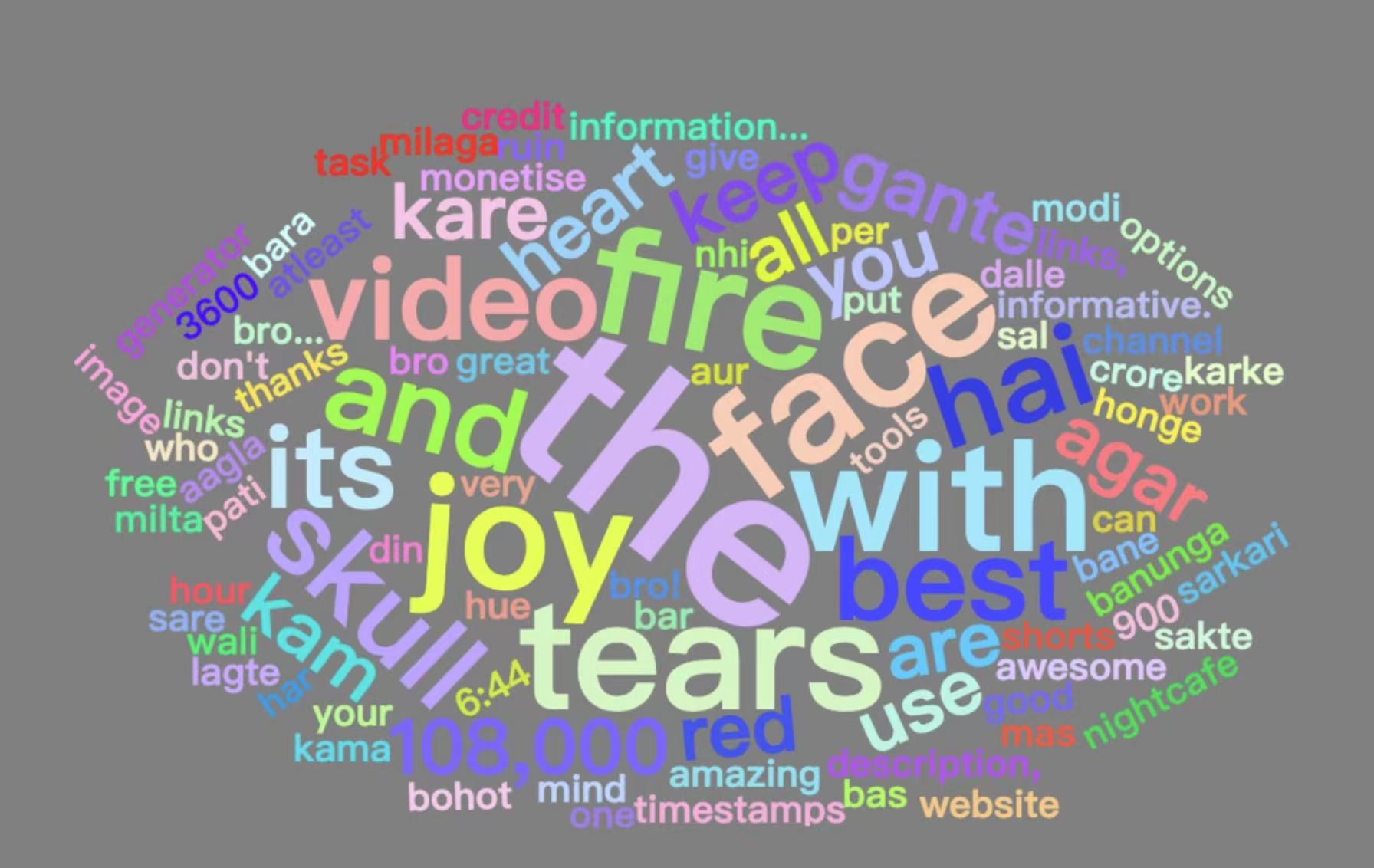
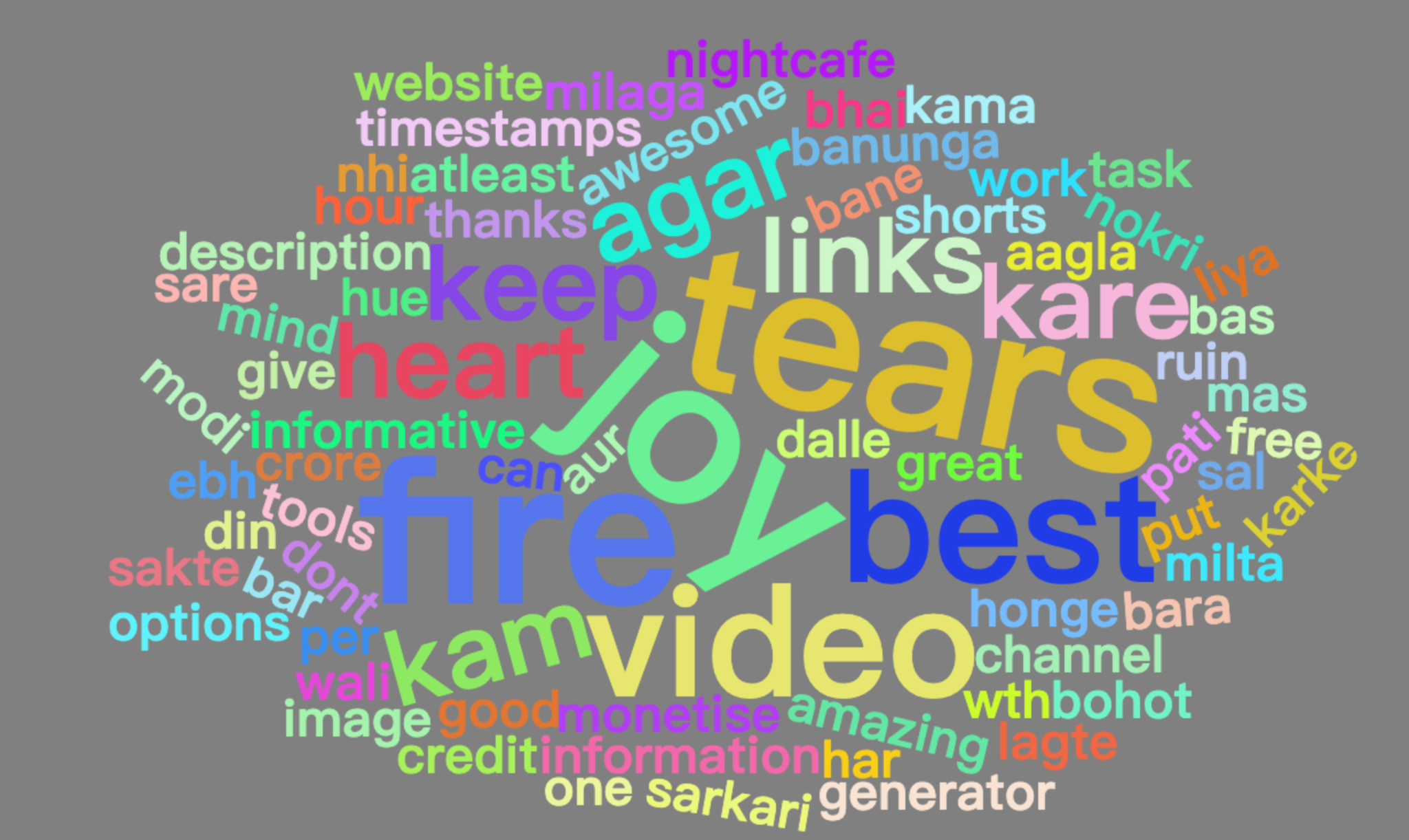
Figure 11: word cloud operation outcome on artists channel (left)
Figure 12: word cloud operation outcome on technicians channel (right)
Figure 11 and 12 visualize the most frequent words that are used in each video. In both word clouds, prominent terms like "joy," "fire," "tears," and "video" are common across both the artist and technician channels, reflecting emotional and multimedia-related discussions. In the artist channel (left), words like "face," "skull," and "use" suggest more varied emotional and thematic concerns, while in the technician channel (right), words like "heart," "best," and "links" emphasize practical and positive interactions with AI technology. Both clouds highlight emotional responses, with a mix of technical and creative terms.

Figure 13: SENA analysis of sentiments of comments for artists channel
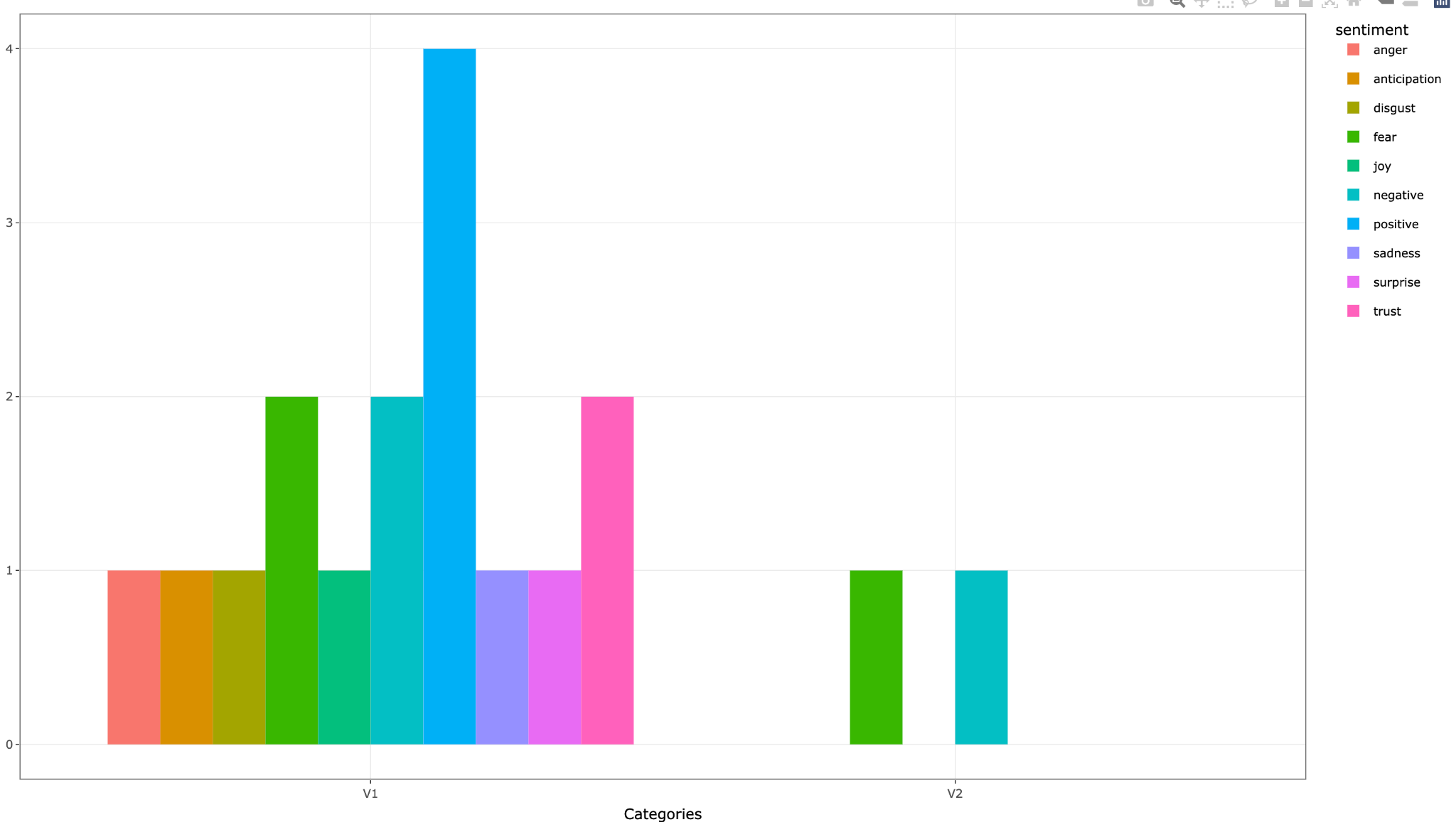
Figure 14: SENA analysis of sentiments of comments for technicians channel
To analyze people’s sentiment distributions, we also utilize SENA to analyze the emotion distribution by opting for the 20 most representative comments in artist channel and technician channel. In Figure 13, while there are visible traces of negative emotions like "fear," "disgust," and "sadness," the dominant sentiments are positive, particularly “joy” and "trust." This suggests that, even though many artists express skepticism about AI, there is a considerable portion of the community that is optimistic or open to AI's potential. The large presence of "joy" indicates that some artists may view AI as a tool that can enhance or complement their work rather than completely disrupt it.
In the technician channel, as highlighted in Figure 14, the overall sentiment is largely positive, with emotions like "trust" standing out. Even though the negative emotions, particularly fear, are still of the dominant presence in topic 2, these are far less common than the positive emotions revealed in topic 1. This result indicates that most technicians seem optimistic about AI’s potential in creative fields. They treat AI tools as an approach to boost their innovation and efficiency, rather than focusing on job replacements and other risk factors.
In fact, the feelings of trust and joy were dominant in both groups, with only small concerns about AI-a general sense that was more open and excited about what AI could bring to art and creativity. Both groups seem ready to explore the possibilities AI offers, though there still lingers doubt.
5. Discussion
The findings give valuable insight into the general discussion of AI-generated art, but most importantly, regarding OpenAI's recently released Sora: Sentiment Analysis of YouTube Comments, here is a look at some key trends that emerge from this analysis. First, Sora has widened the conversation, with more topics getting discussed; there was a major spike in positive sentiments. It also went from three topics to four, and the discussions became much more complete, not only regarding how AI is used in creating art but also considering its applications in various fields and the impact it can have on society altogether.
In addition, public opinion about AI-generated art has become more positive. Some people believe everything connected with technology is a significant achievement, while others raise ethical controversies. Since Sora's release, trust and positive feelings have grown, which can be said to reflect that the public is warming up toward AI-generated art, considering it a tool that could expand creative possibilities and make it more efficient. However, fear has risen. Even with many technicians holding the belief that AI inspires productivity, most human artists regard AI as a threat to their jobs.
Interestingly enough, though both groups bear a generally optimistic feeling toward AI, the concerns they have are different. Media outlets like NBC present creative possibilities with AI in a much more positive view. Contrasting this is WSJ, which cites regulatory and social risks coming from the wide adoptions of AI. Despite these, indeed, the overall sentiment goes toward excitement and openness about what AI can bring into a world of creativity. On the whole, results have indicated there is indeed a significant change in the mind of the public towards AI-generated art-a change from mixed skepticism to growing optimism. This finally indicates a shift in sentiment from the previous studies, which had indicated that initially, consumers of art viewed AI-generated works with negative bias, while over time, through exposure to AI technologies, positive feelings toward AI creative works are developed.
The popularity of Sora upon its release is consistent with the larger trend in creative industries, especially in those areas where efficiency and innovation are increasingly embraced. Nevertheless, the fear conveyed by the human artists in our results puts this in the context of a larger debate about the place of AI in creativity-a theme recurring in previous studies exploring the impact of AI on artistic labor and other issues, such as copyright infringement [1,18] . This also aligns with the existing literature, as the difference in reaction between art critics, professional artists, and consumers to AI-generated art would suggest that while the everyday user may appreciate the novelty and practical benefits of AI, professional artists are more concerned with ethical issues and possibly losing art's originality. The danger of losing one's job, coupled with illegal uses of copyright by the artists themselves, is an echo of the findings of Epstein [17] on the economic risks AI places on the creative industry. This division underlines the complexities of integrating AI in the artistic world, since the technology continues to raise a plethora of questions in traditional concepts of creativity and ownership.
The results corroborate the notion that media framing plays a crucial role in shaping public opinion. Similar to Brewer [14], who found that positive media messages about AI tools increase public support, our analysis shows that Sora’s portrayal as a tool for creativity has fostered a more favorable perception. Our study also supports the findings of Zaheer [15], which highlight the influence of political ideologies on perceptions of AI and the focus on regulations. Furthermore, the selection of AI tools may also impact the viewpoints of different parties. OpenAI is a potentially left-leaning AI tool, indicating that it might have more democratic supporters. The situation may be different if we analyze a different AI tool.
6. Limitation
Three aspects of study require some caution when interpreting the results: The primary limitation is reliance on a relatively small sample size, which was confined to YouTube English comments under a few channels. This restricts the generalizability of the findings across other social media platforms and demographics, such as Twitter, Facebook, or Instagram. Consequently, caution should be exercised when generalizing the findings beyond YouTube. Meanwhile, the analysis period, two months before and after the release of Sora, may be too short to detect a long-term trend in public opinion. Future studies should consider an increased sample size that includes data from other platforms, as well as longer observation periods, if the goal is to better understand the public discourse of AI-generated art.
Language use can also limit the availability of the tools for quantitative sentiment analysis. This study removes all non-English, stop words, numeric characters, and punctuation, but all misspellings, slang, grammatical errors, and other pitfalls of expression can only be removed through data cleaning. Such wording problems can also make it difficult to detect the emotions accurately by MDCOR and SENA. [34]. Sentiment analysis tools also struggle to identify vague or sarcastic expressions of emotions. For instance, sarcastic sentences often appear positive but carry negative connotations, leading to confusion and bias in emotion detection systems [35] . Determining the dominant emotion in a sentence is challenging because sentences often express multiple emotions, both positive and negative [33].
Third, the subjective nature of qualitative analysis, particularly in interpreting emotions on AI art influence on creative industries and labor market, also introduces the potential for bias in the results. This study captures the trend of AI technology’s contribution in creative output and application in several industries, but only uses content analysis as the method. Future research could use more diverse methods to explore long-term impact of AI art on these aspects. Studying the role of policies and regulations in addressing ethical challenges posed by AI and safeguarding the rights and interests of human artists would also be a valuable direction for future exploration.
7. Conclusion
The study provides insights into the evolving public opinion on AI-generated art, particularly following the significant breakthrough—the release of Sora by OpenAI. While the general public is increasingly accepting AI as a tool for artistic creation, significant concerns also remain, which are among professional artists who worry about ethical issues and potential job losses. The findings emphasize the importance of acknowledging the diverse perspectives of key stakeholders—general consumers, artists, and technicians—as AI continues to shape the creative industries. The general consumers seem to enjoy the efficiency and novelty that AI brings forth, while artists seem to focus on the threats to originality and livelihood. Technicians primarily view AI as a technological benefit.
The same study indicates that media framing also molds public opinion, as left-leaning outlets frame AI as a creative force, while right-leaning platforms have focused on issues related to regulatory challenges and societal risks.
These findings have a number of implications for policymakers, artists, and technologists. Necessary policies will arise that balance the encouragement of innovation and protection for human creators as AI will become increasingly integrated into creative fields. The regulatory frameworks have to consider issues related to copyright, use of data, and job displacement so that technology moves forward while ethical concerns are still met.
It may thus be interpreted that the artist who learns to work with AI, rather than against it, will see new creative avenues open for them and will emerge as a winner in the AI-affected world. The challenge for technologists is therefore in the design of AI tools that act to extend, rather than replace, human creativity, fostering an environment of coexistence of human and machine-generated art.
Finally, this study insists on the need to open a dialogue among artists, technicians, and policymakers, taking into consideration different standpoints of interest so that AI and human creativity can develop together in an ethical and innovative fashion for mutual benefit.
Acknowledgement
Mingxi Wu and Wanchen Yu contributed equally to this work and should be considered co-first authors.
References
[1]. Z. Epstein, S. Levine, D. G. Rand, and I. Rahwan, “Who Gets Credit for AI-Generated Art?,” iScience, vol. 23, no. 9, p. 101515, Sep. 2020, doi: https://doi.org/10.1016/j.isci.2020.101515.
[2]. F.-Y. Wang et al., “When Does Sora Show: The Beginning of TAO to Imaginative Intelligence and Scenarios Engineering,” IEEE/CAA journal of automatica sinica, vol. 11, no. 4, pp. 809–815, Apr. 2024, doi: https://doi.org/10.1109/jas.2024.124383.
[3]. Y. Liu et al., “Sora: A Review on Background, Technology, Limitations, and Opportunities of Large Vision Models,” arXiv.org, Feb. 28, 2024. https://arxiv.org/abs/2402.17177
[4]. B. Liu, “Arguments for the Rise of Artificial Intelligence Art: Does AI Art Have Creativity, Motivation, Self-awareness and Emotion?,” Arte, Individuo Y Sociedad, vol. 35, no. 3, pp. 1–11, Apr. 2023, doi: https://doi.org/10.5209/aris.83808.
[5]. S. Chiodo, “What AI ‘art’ can teach us about art,” Journal of AESTHETICS & CULTURE, vol. 16, no. 1, Aug. 2024, doi: https://doi.org/10.1080/20004214.2024.2395511.
[6]. A.-P. Buraga, “The Emergence of the Type-Generated AI Art Community : A Netnographic and Content Analysis Approach,” DIVA, 2022. https://www.diva-portal.org/smash/record.jsf?pid=diva2%3A1695233&dswid=-722 (accessed Sep. 29, 2024).
[7]. R. Latikka, J. Bergdahl, N. Savela, and A. Oksanen, “AI as an Artist? A Two-Wave Survey Study on Attitudes Toward Using Artificial Intelligence in Art,” Poetics, vol. 101, no. 101839, pp. 101839–101839, Dec. 2023, doi: https://doi.org/10.1016/j.poetic.2023.101839.
[8]. E. Zhou and D. Lee, “Generative artificial intelligence, human creativity, and art,” PNAS Nexus, vol. 3, no. 3, Mar. 2024, doi: https://doi.org/10.1093/pnasnexus/pgae052.
[9]. J.-W. Hong and N. M. Curran, “Artificial Intelligence, Artists, and Art: Attitudes Toward Artwork Produced by Humans vs. Artificial Intelligence,” ACM Transactions on Multimedia Computing, Communications, and Applications, vol. 15, no. 2s, pp. 1–16, Aug. 2019, doi: https://doi.org/10.1145/3326337.
[10]. E. S. Mikalonytė and M. Kneer, “Can Artificial Intelligence Make Art?,” ACM Transactions on Human-Robot Interaction, vol. 11, no. 4, May 2022, doi: https://doi.org/10.1145/3530875.
[11]. K. Millet, F. Buehler, G. Du, and M. Kokkoris, “Defending humankind: Anthropocentric bias in the appreciation of AI art,” Computers in Human Behavior, vol. 143, no. 0747-5632, p. 107707, Feb. 2023, doi: https://doi.org/10.1016/j.chb.2023.107707.
[12]. U. Messer, “Co-creating art with generative artificial intelligence: Implications for artworks and artists,” Computers in Human Behavior Artificial Humans, vol. 2, no. 1, pp. 100056–100056, Feb. 2024, doi: https://doi.org/10.1016/j.chbah.2024.100056.
[13]. L. Bellaiche et al., “Humans versus AI: Whether and why we prefer human-created compared to AI-created artwork,” Cognitive Research: Principles and Implications, vol. 8, no. 1, Jul. 2023, doi: https://doi.org/10.1186/s41235-023-00499-6.
[14]. P. R. Brewer, L. Cuddy, W. Dawson, and R. Stise, “Artists or art thieves? media use, media messages, and public opinion about artificial intelligence image generators,” AI & SOCIETY, Jan. 2024, doi: https://doi.org/10.1007/s00146-023-01854-3.
[15]. A. Zaheer, “The Politics Behind AI: How Political Beliefs Drive Opinions on Artificial Intelligence in California,” Escholarship.org, Feb. 06, 2024. https://escholarship.org/uc/item/1tn9z87k (accessed Dec. 06, 2024).
[16]. M. R. Frank, “Toward Understanding the Impact of Artificial Intelligence on Labor,” Proceedings of the National Academy of Sciences, vol. 116, no. 14, pp. 6531–6539, Mar. 2019, doi: https://doi.org/10.1073/pnas.1900949116.
[17]. Z. Epstein et al., “Art and the Science of Generative AI,” Science, vol. 380, no. 6650, pp. 1110–1111, Jun. 2023, doi: https://doi.org/10.1126/science.adh4451.
[18]. H. Jiang et al., “AI Art and Its Impact on Artists,” AIES ’23: Proceedings of the 2023 AAAI/ACM Conference on AI, Ethics, and Society, pp. 363–374, Aug. 2023, doi: https://doi.org/10.1145/3600211.3604681.
[19]. Chawinthorn Watiktinnakorn, Jirawat Seesai, and Chutisant Kerdvibulvech, “Blurring the lines: how AI is redefining artistic ownership and copyright,” Discover Artificial Intelligence, vol. 3, no. 1, Nov. 2023, doi: https://doi.org/10.1007/s44163-023-00088-y.
[20]. S. Schindler and A. Haines, "AI art and copyright," Business Law International, vol. 25, no. 2, pp. 191–102, 2024.
[21]. R. H. Mogavi et al., “Sora OpenAI’s Prelude: Social Media Perspectives on Sora OpenAI and the Future of AI Video Generation,” arXiv.org, Mar. 01, 2024. https://arxiv.org/abs/2403.14665
[22]. V. V. Parikh, “Analysing the Public Discourse around OpenAI’s Text-To-Video Model ‘Sora’ using Topic Modeling,” arXiv.org, 2024. https://arxiv.org/abs/2407.13071
[23]. M. S. González Canché, “Machine driven classification of open-ended responses (MDCOR): An analytic framework and no-code, free software application to classify longitudinal and cross-sectional text responses in survey and social media research,” Expert Systems with Applications, vol. 215, p. 119265, Apr. 2023, doi: https://doi.org/10.1016/j.eswa.2022.119265.
[24]. “Pro Artist vs A.I. Art 🖌️🤖 (WHO WINS?!) #shorts,” www.youtube.com. https://www.youtube.com/shorts/JV6jqrFrjEQ
[25]. “Why AI art is so controversial,” www.youtube.com. https://www.youtube.com/shorts/47USKNRqHUQ
[26]. Tech Burner, “7 Majedaar AI Tools you Should Try !,” YouTube, Dec. 04, 2023. https://www.youtube.com/watch?v=4qVRFgRcFkk
[27]. “No, Ai ‘Art’ is not Art.,” www.youtube.com. https://www.youtube.com/watch?v=ESZO-XJZr0s
[28]. S. Yang, “Why Artists are Fed Up with AI Art.,” www.youtube.com, Dec. 24, 2022. https://www.youtube.com/watch?v=5Viy3Cu3DLk
[29]. “AI Generated Videos Just Changed Forever,” www.youtube.com. https://www.youtube.com/watch?v=NXpdyAWLDas
[30]. “OpenAI unveils text-to-video tool Sora,” www.youtube.com. https://www.youtube.com/watch?v=SkCz4LqzNF4
[31]. “Watch: OpenAI Tool Creates Realistic AI Videos | WSJ News,” www.youtube.com. https://www.youtube.com/watch?v=anmuklFtu8U
[32]. I. Onyenwe, S. Nwagbo, N. Mbeledogu, and E. Onyedinma, “The impact of political party/candidate on the election results from a sentiment analysis perspective using #AnambraDecides2017 tweets,” Social Network Analysis and Mining, vol. 10, no. 1, Jul. 2020, doi: https://doi.org/10.1007/s13278-020-00667-2.
[33]. P. Nandwani and R. Verma, “A review on sentiment analysis and emotion detection from text,” Social Network Analysis and Mining, vol. 11, no. 1, Aug. 2021, doi: https://doi.org/10.1007/s13278-021-00776-6.
[34]. E. Batbaatar, M. Li, and K. H. Ryu, “Semantic-Emotion Neural Network for Emotion Recognition From Text,” IEEE Access, vol. 7, pp. 111866–111878, 2019, doi: https://doi.org/10.1109/ACCESS.2019.2934529.
[35]. F. Ghanbari-Adivi and M. Mosleh, “Text emotion detection in social networks using a novel ensemble classifier based on Parzen Tree Estimator (TPE),” Neural Computing and Applications, vol. 31, no. 12, pp. 8971–8983, May 2019, doi: https://doi.org/10.1007/s00521-019-04230-9.
Cite this article
Wu,M.;Yu,W.;Lu,J.;Cheng,Z.;Xin,J. (2025). Embrace or Resist: Public Opinion of AI Art in the Age of Sora. Applied and Computational Engineering,134,151-170.
Data availability
The datasets used and/or analyzed during the current study will be available from the authors upon reasonable request.
Disclaimer/Publisher's Note
The statements, opinions and data contained in all publications are solely those of the individual author(s) and contributor(s) and not of EWA Publishing and/or the editor(s). EWA Publishing and/or the editor(s) disclaim responsibility for any injury to people or property resulting from any ideas, methods, instructions or products referred to in the content.
About volume
Volume title: Proceedings of the 5th International Conference on Signal Processing and Machine Learning
© 2024 by the author(s). Licensee EWA Publishing, Oxford, UK. This article is an open access article distributed under the terms and
conditions of the Creative Commons Attribution (CC BY) license. Authors who
publish this series agree to the following terms:
1. Authors retain copyright and grant the series right of first publication with the work simultaneously licensed under a Creative Commons
Attribution License that allows others to share the work with an acknowledgment of the work's authorship and initial publication in this
series.
2. Authors are able to enter into separate, additional contractual arrangements for the non-exclusive distribution of the series's published
version of the work (e.g., post it to an institutional repository or publish it in a book), with an acknowledgment of its initial
publication in this series.
3. Authors are permitted and encouraged to post their work online (e.g., in institutional repositories or on their website) prior to and
during the submission process, as it can lead to productive exchanges, as well as earlier and greater citation of published work (See
Open access policy for details).
References
[1]. Z. Epstein, S. Levine, D. G. Rand, and I. Rahwan, “Who Gets Credit for AI-Generated Art?,” iScience, vol. 23, no. 9, p. 101515, Sep. 2020, doi: https://doi.org/10.1016/j.isci.2020.101515.
[2]. F.-Y. Wang et al., “When Does Sora Show: The Beginning of TAO to Imaginative Intelligence and Scenarios Engineering,” IEEE/CAA journal of automatica sinica, vol. 11, no. 4, pp. 809–815, Apr. 2024, doi: https://doi.org/10.1109/jas.2024.124383.
[3]. Y. Liu et al., “Sora: A Review on Background, Technology, Limitations, and Opportunities of Large Vision Models,” arXiv.org, Feb. 28, 2024. https://arxiv.org/abs/2402.17177
[4]. B. Liu, “Arguments for the Rise of Artificial Intelligence Art: Does AI Art Have Creativity, Motivation, Self-awareness and Emotion?,” Arte, Individuo Y Sociedad, vol. 35, no. 3, pp. 1–11, Apr. 2023, doi: https://doi.org/10.5209/aris.83808.
[5]. S. Chiodo, “What AI ‘art’ can teach us about art,” Journal of AESTHETICS & CULTURE, vol. 16, no. 1, Aug. 2024, doi: https://doi.org/10.1080/20004214.2024.2395511.
[6]. A.-P. Buraga, “The Emergence of the Type-Generated AI Art Community : A Netnographic and Content Analysis Approach,” DIVA, 2022. https://www.diva-portal.org/smash/record.jsf?pid=diva2%3A1695233&dswid=-722 (accessed Sep. 29, 2024).
[7]. R. Latikka, J. Bergdahl, N. Savela, and A. Oksanen, “AI as an Artist? A Two-Wave Survey Study on Attitudes Toward Using Artificial Intelligence in Art,” Poetics, vol. 101, no. 101839, pp. 101839–101839, Dec. 2023, doi: https://doi.org/10.1016/j.poetic.2023.101839.
[8]. E. Zhou and D. Lee, “Generative artificial intelligence, human creativity, and art,” PNAS Nexus, vol. 3, no. 3, Mar. 2024, doi: https://doi.org/10.1093/pnasnexus/pgae052.
[9]. J.-W. Hong and N. M. Curran, “Artificial Intelligence, Artists, and Art: Attitudes Toward Artwork Produced by Humans vs. Artificial Intelligence,” ACM Transactions on Multimedia Computing, Communications, and Applications, vol. 15, no. 2s, pp. 1–16, Aug. 2019, doi: https://doi.org/10.1145/3326337.
[10]. E. S. Mikalonytė and M. Kneer, “Can Artificial Intelligence Make Art?,” ACM Transactions on Human-Robot Interaction, vol. 11, no. 4, May 2022, doi: https://doi.org/10.1145/3530875.
[11]. K. Millet, F. Buehler, G. Du, and M. Kokkoris, “Defending humankind: Anthropocentric bias in the appreciation of AI art,” Computers in Human Behavior, vol. 143, no. 0747-5632, p. 107707, Feb. 2023, doi: https://doi.org/10.1016/j.chb.2023.107707.
[12]. U. Messer, “Co-creating art with generative artificial intelligence: Implications for artworks and artists,” Computers in Human Behavior Artificial Humans, vol. 2, no. 1, pp. 100056–100056, Feb. 2024, doi: https://doi.org/10.1016/j.chbah.2024.100056.
[13]. L. Bellaiche et al., “Humans versus AI: Whether and why we prefer human-created compared to AI-created artwork,” Cognitive Research: Principles and Implications, vol. 8, no. 1, Jul. 2023, doi: https://doi.org/10.1186/s41235-023-00499-6.
[14]. P. R. Brewer, L. Cuddy, W. Dawson, and R. Stise, “Artists or art thieves? media use, media messages, and public opinion about artificial intelligence image generators,” AI & SOCIETY, Jan. 2024, doi: https://doi.org/10.1007/s00146-023-01854-3.
[15]. A. Zaheer, “The Politics Behind AI: How Political Beliefs Drive Opinions on Artificial Intelligence in California,” Escholarship.org, Feb. 06, 2024. https://escholarship.org/uc/item/1tn9z87k (accessed Dec. 06, 2024).
[16]. M. R. Frank, “Toward Understanding the Impact of Artificial Intelligence on Labor,” Proceedings of the National Academy of Sciences, vol. 116, no. 14, pp. 6531–6539, Mar. 2019, doi: https://doi.org/10.1073/pnas.1900949116.
[17]. Z. Epstein et al., “Art and the Science of Generative AI,” Science, vol. 380, no. 6650, pp. 1110–1111, Jun. 2023, doi: https://doi.org/10.1126/science.adh4451.
[18]. H. Jiang et al., “AI Art and Its Impact on Artists,” AIES ’23: Proceedings of the 2023 AAAI/ACM Conference on AI, Ethics, and Society, pp. 363–374, Aug. 2023, doi: https://doi.org/10.1145/3600211.3604681.
[19]. Chawinthorn Watiktinnakorn, Jirawat Seesai, and Chutisant Kerdvibulvech, “Blurring the lines: how AI is redefining artistic ownership and copyright,” Discover Artificial Intelligence, vol. 3, no. 1, Nov. 2023, doi: https://doi.org/10.1007/s44163-023-00088-y.
[20]. S. Schindler and A. Haines, "AI art and copyright," Business Law International, vol. 25, no. 2, pp. 191–102, 2024.
[21]. R. H. Mogavi et al., “Sora OpenAI’s Prelude: Social Media Perspectives on Sora OpenAI and the Future of AI Video Generation,” arXiv.org, Mar. 01, 2024. https://arxiv.org/abs/2403.14665
[22]. V. V. Parikh, “Analysing the Public Discourse around OpenAI’s Text-To-Video Model ‘Sora’ using Topic Modeling,” arXiv.org, 2024. https://arxiv.org/abs/2407.13071
[23]. M. S. González Canché, “Machine driven classification of open-ended responses (MDCOR): An analytic framework and no-code, free software application to classify longitudinal and cross-sectional text responses in survey and social media research,” Expert Systems with Applications, vol. 215, p. 119265, Apr. 2023, doi: https://doi.org/10.1016/j.eswa.2022.119265.
[24]. “Pro Artist vs A.I. Art 🖌️🤖 (WHO WINS?!) #shorts,” www.youtube.com. https://www.youtube.com/shorts/JV6jqrFrjEQ
[25]. “Why AI art is so controversial,” www.youtube.com. https://www.youtube.com/shorts/47USKNRqHUQ
[26]. Tech Burner, “7 Majedaar AI Tools you Should Try !,” YouTube, Dec. 04, 2023. https://www.youtube.com/watch?v=4qVRFgRcFkk
[27]. “No, Ai ‘Art’ is not Art.,” www.youtube.com. https://www.youtube.com/watch?v=ESZO-XJZr0s
[28]. S. Yang, “Why Artists are Fed Up with AI Art.,” www.youtube.com, Dec. 24, 2022. https://www.youtube.com/watch?v=5Viy3Cu3DLk
[29]. “AI Generated Videos Just Changed Forever,” www.youtube.com. https://www.youtube.com/watch?v=NXpdyAWLDas
[30]. “OpenAI unveils text-to-video tool Sora,” www.youtube.com. https://www.youtube.com/watch?v=SkCz4LqzNF4
[31]. “Watch: OpenAI Tool Creates Realistic AI Videos | WSJ News,” www.youtube.com. https://www.youtube.com/watch?v=anmuklFtu8U
[32]. I. Onyenwe, S. Nwagbo, N. Mbeledogu, and E. Onyedinma, “The impact of political party/candidate on the election results from a sentiment analysis perspective using #AnambraDecides2017 tweets,” Social Network Analysis and Mining, vol. 10, no. 1, Jul. 2020, doi: https://doi.org/10.1007/s13278-020-00667-2.
[33]. P. Nandwani and R. Verma, “A review on sentiment analysis and emotion detection from text,” Social Network Analysis and Mining, vol. 11, no. 1, Aug. 2021, doi: https://doi.org/10.1007/s13278-021-00776-6.
[34]. E. Batbaatar, M. Li, and K. H. Ryu, “Semantic-Emotion Neural Network for Emotion Recognition From Text,” IEEE Access, vol. 7, pp. 111866–111878, 2019, doi: https://doi.org/10.1109/ACCESS.2019.2934529.
[35]. F. Ghanbari-Adivi and M. Mosleh, “Text emotion detection in social networks using a novel ensemble classifier based on Parzen Tree Estimator (TPE),” Neural Computing and Applications, vol. 31, no. 12, pp. 8971–8983, May 2019, doi: https://doi.org/10.1007/s00521-019-04230-9.





